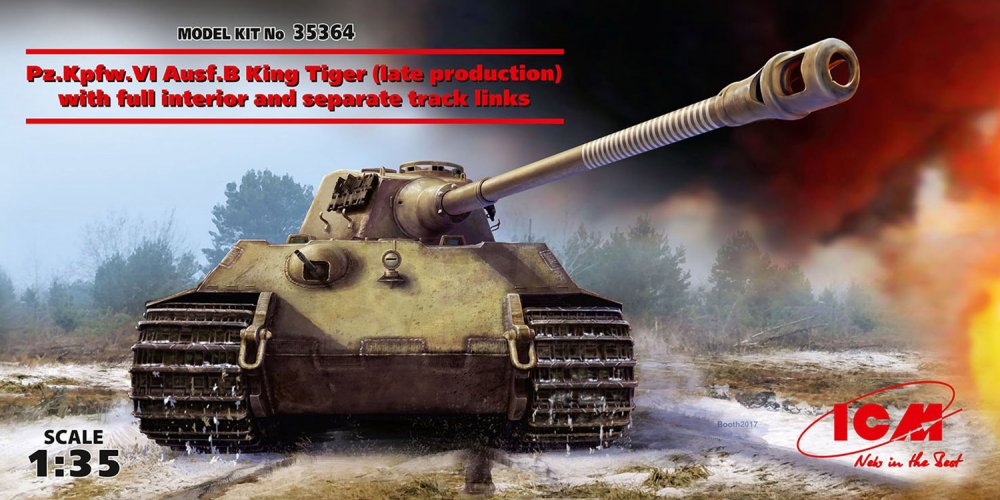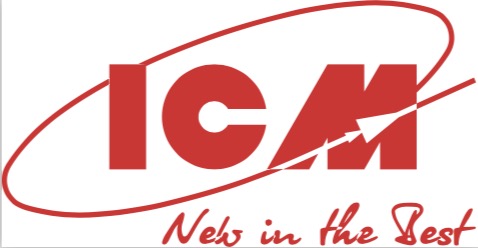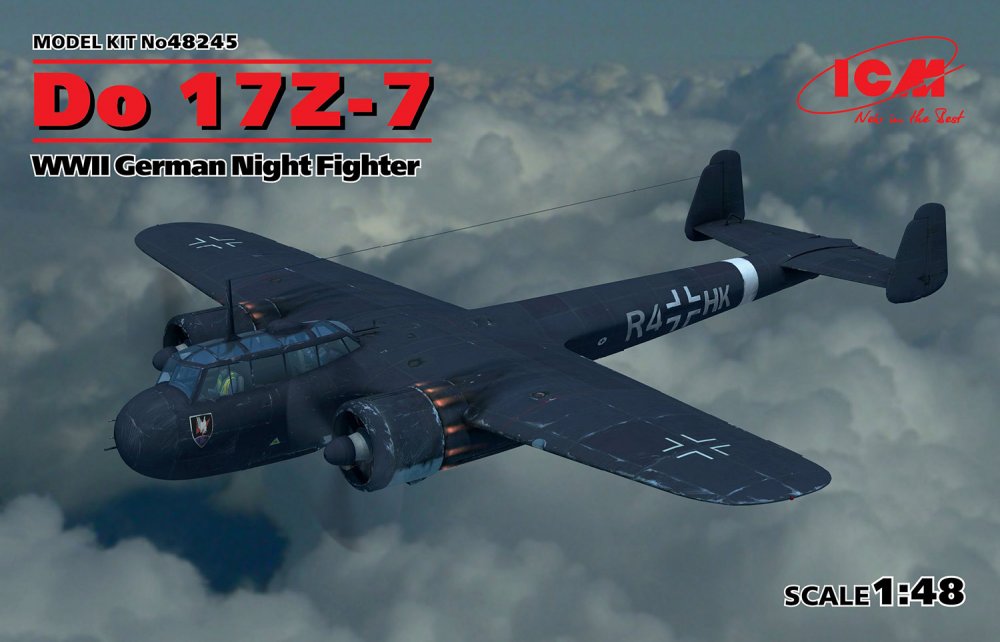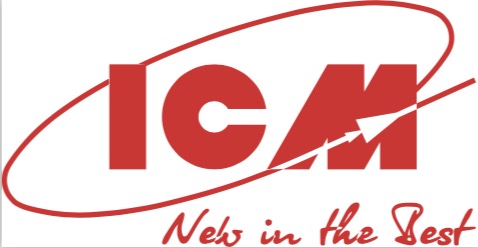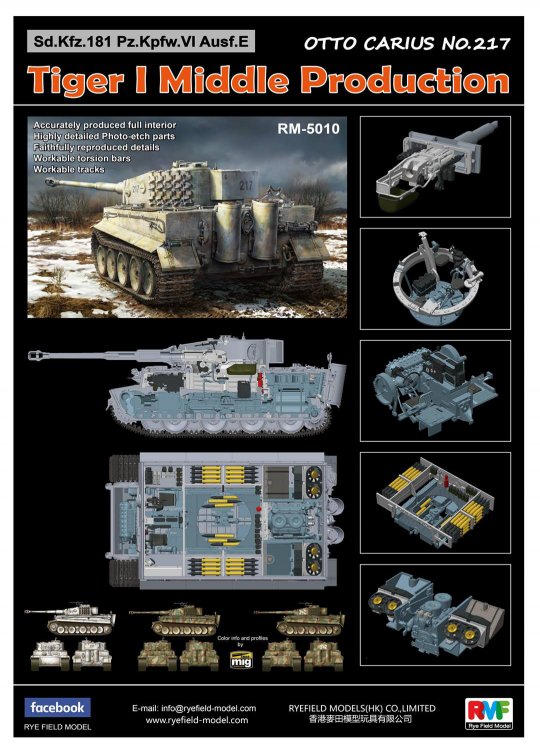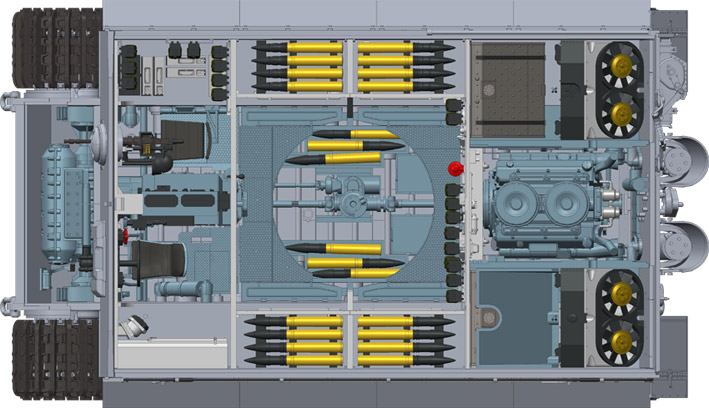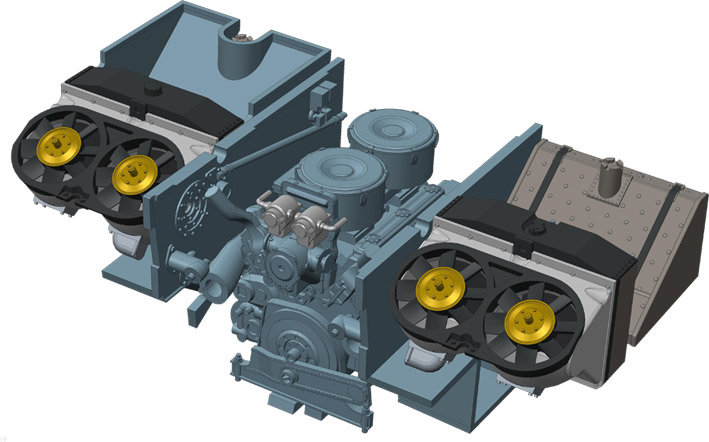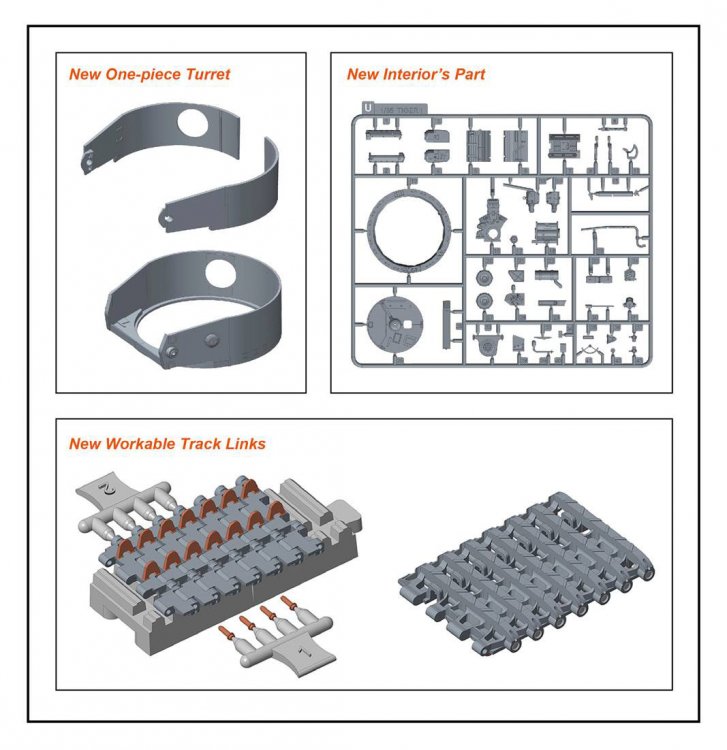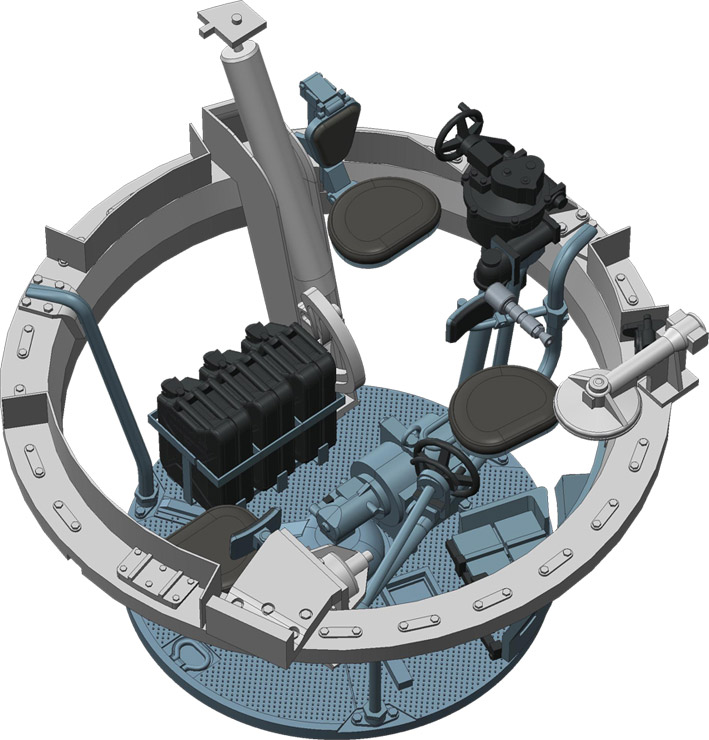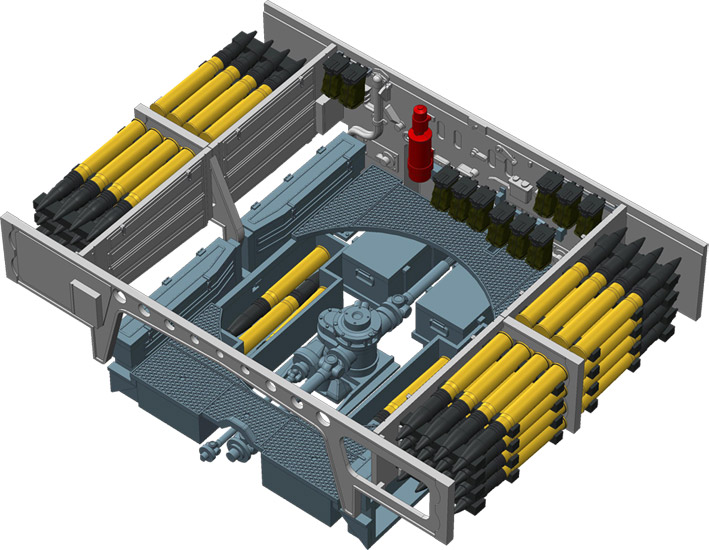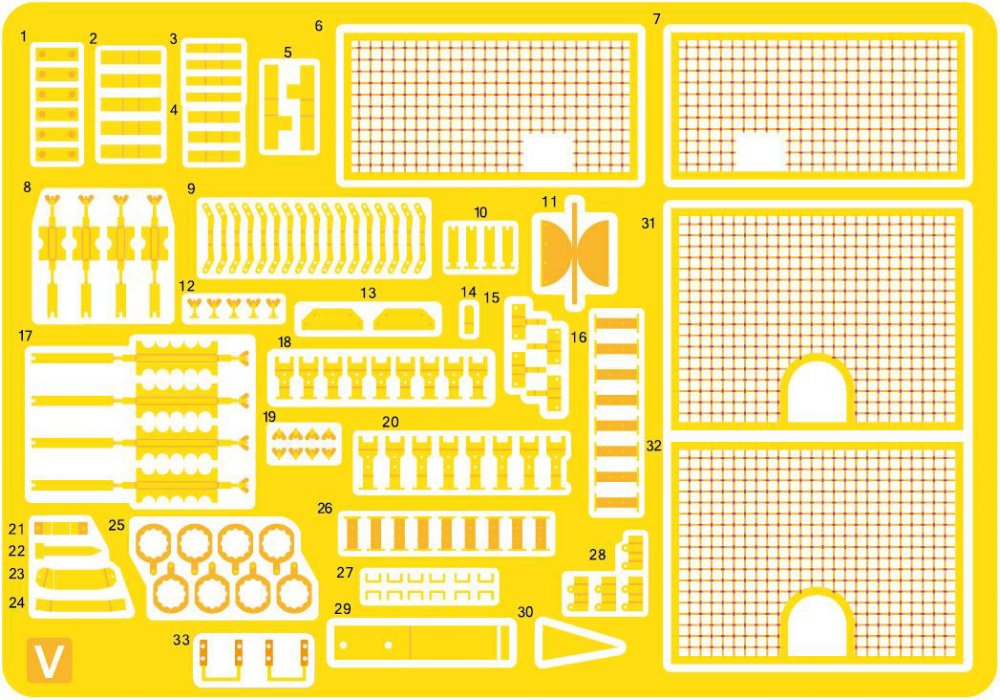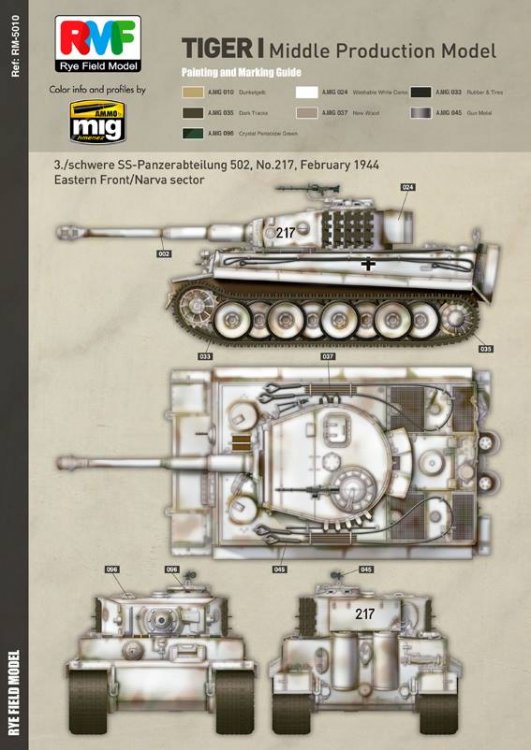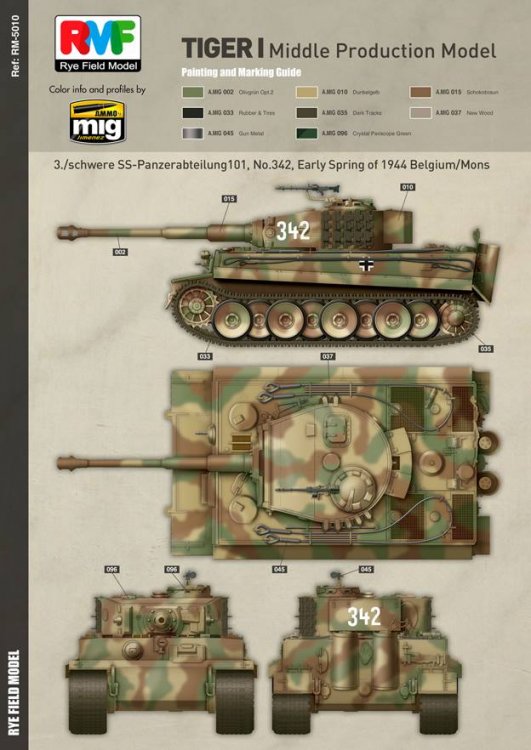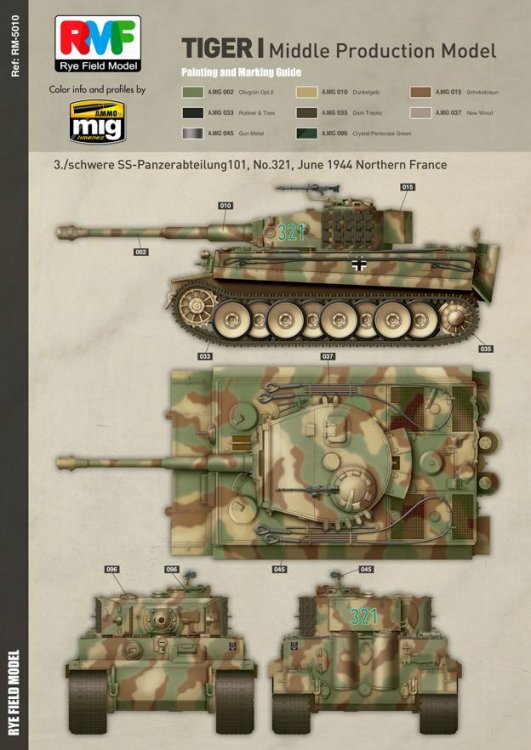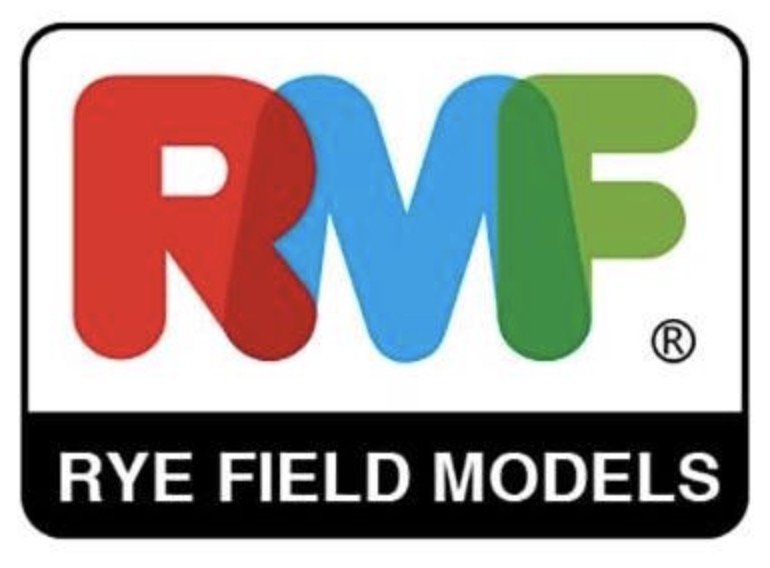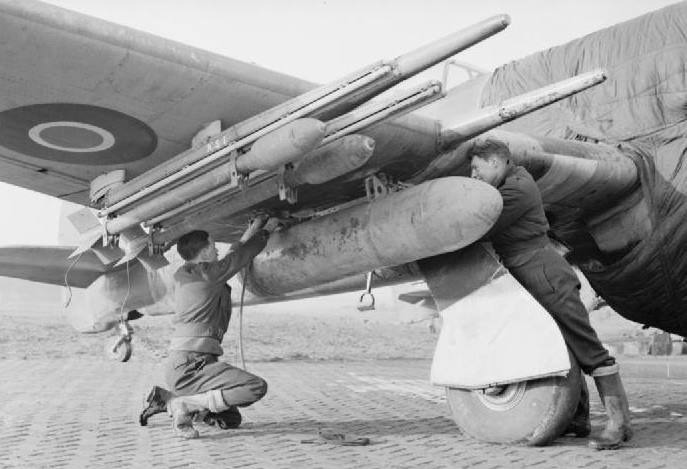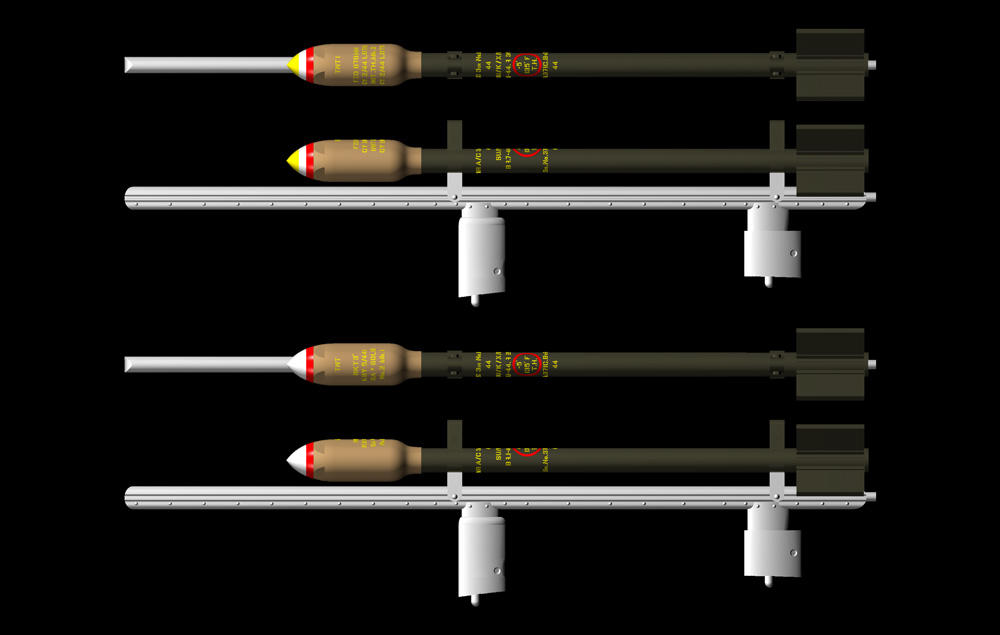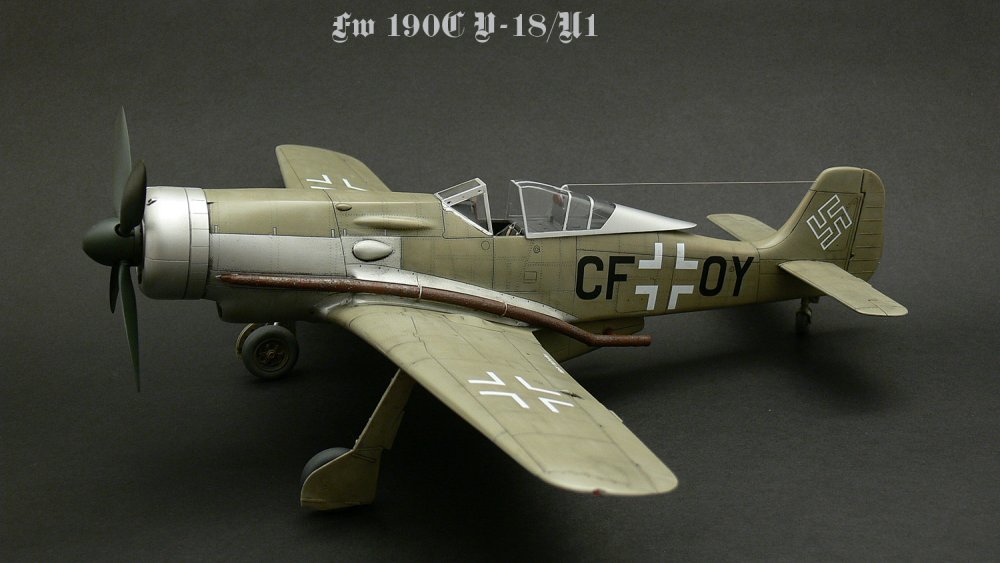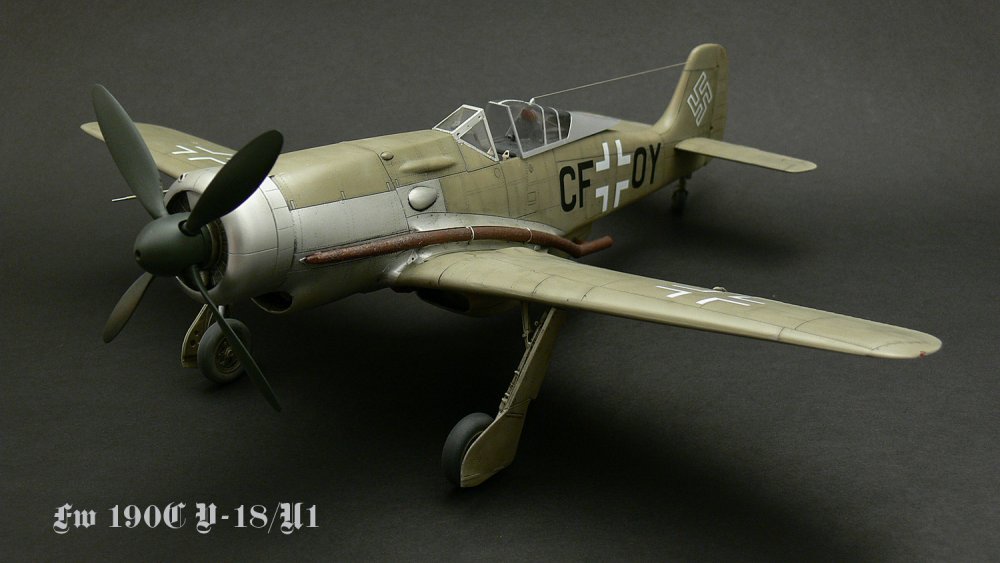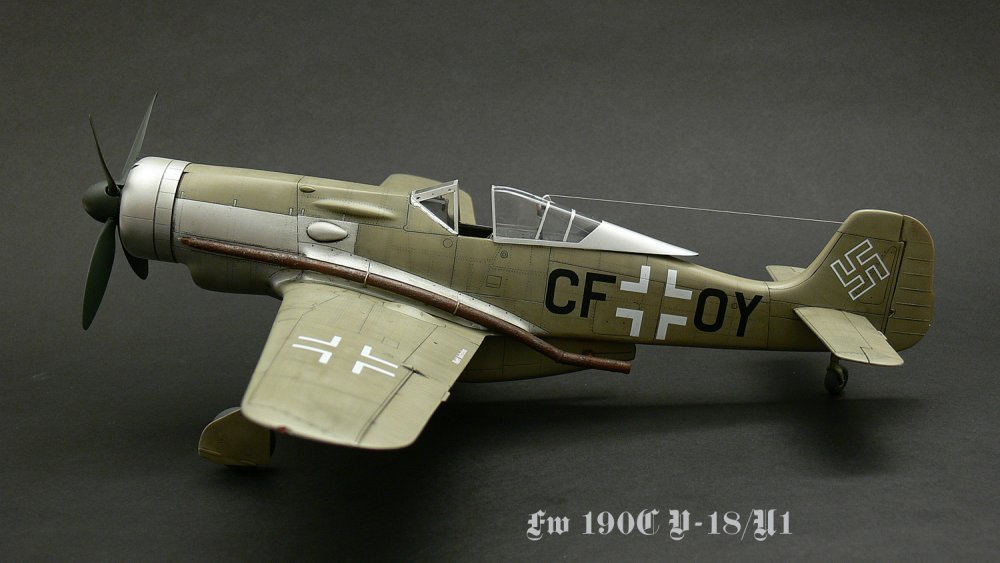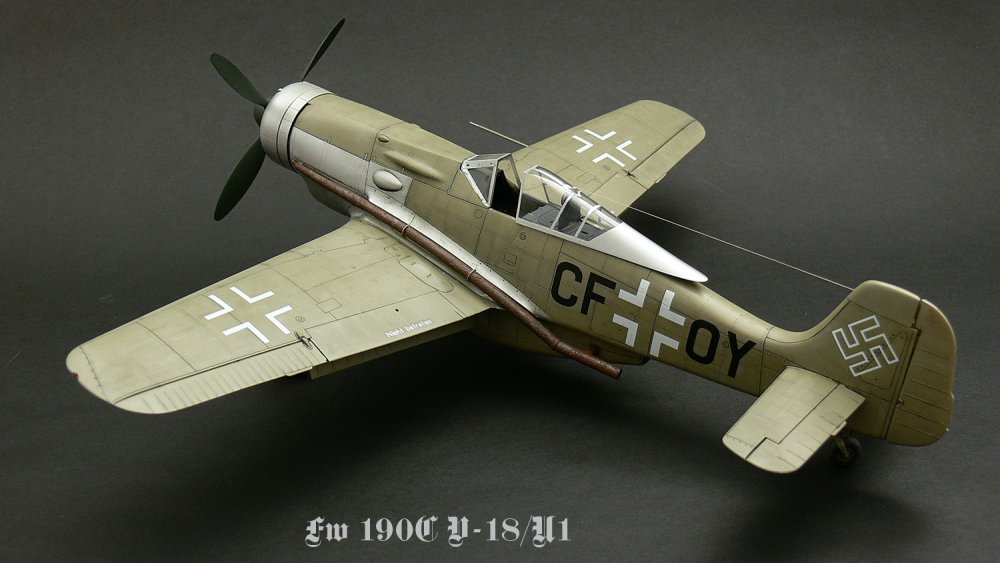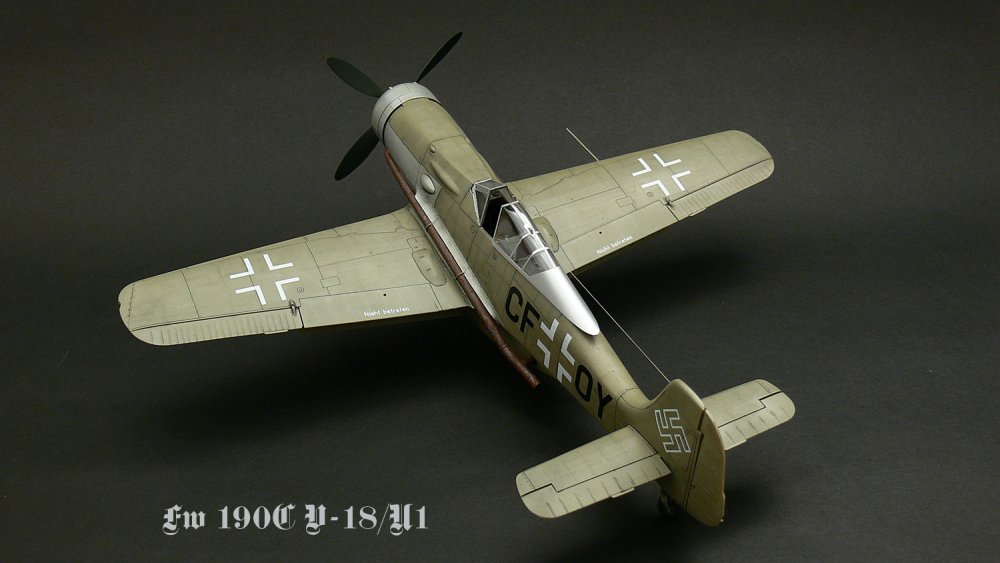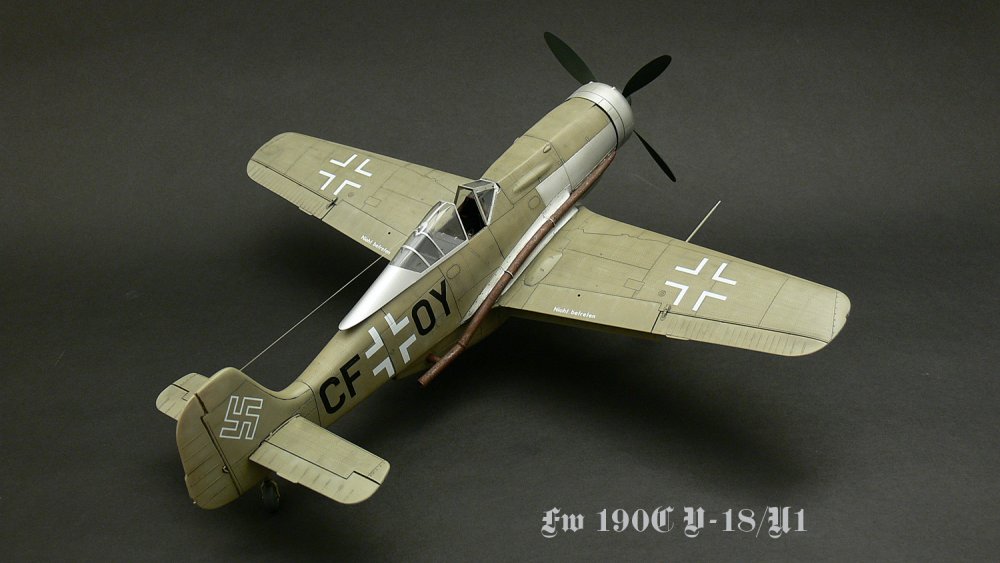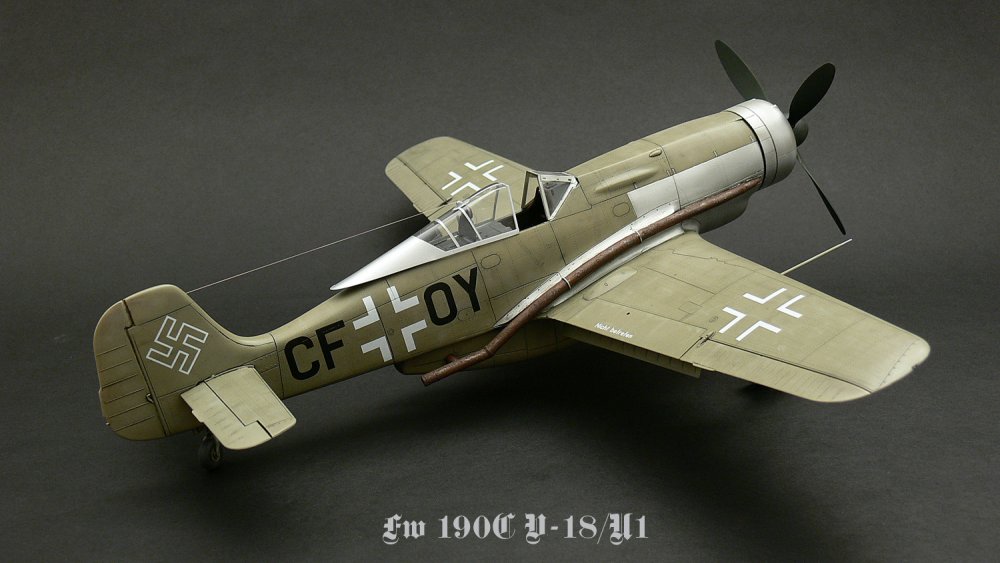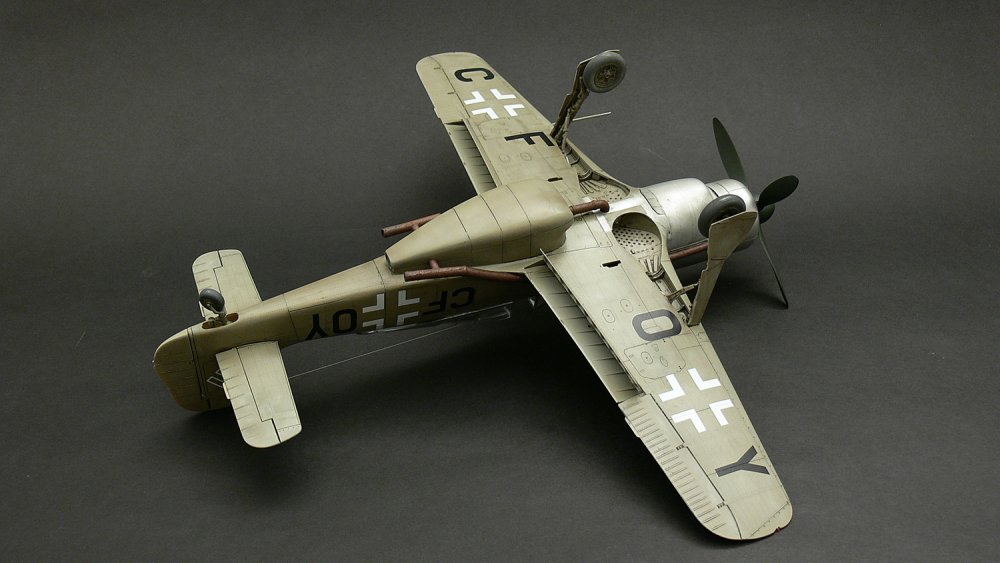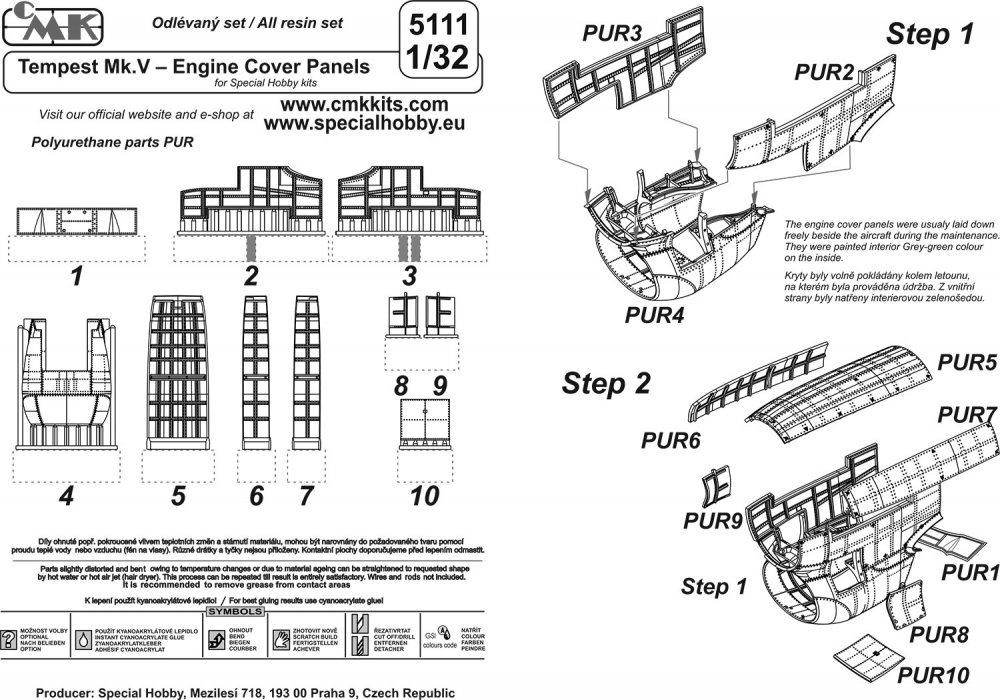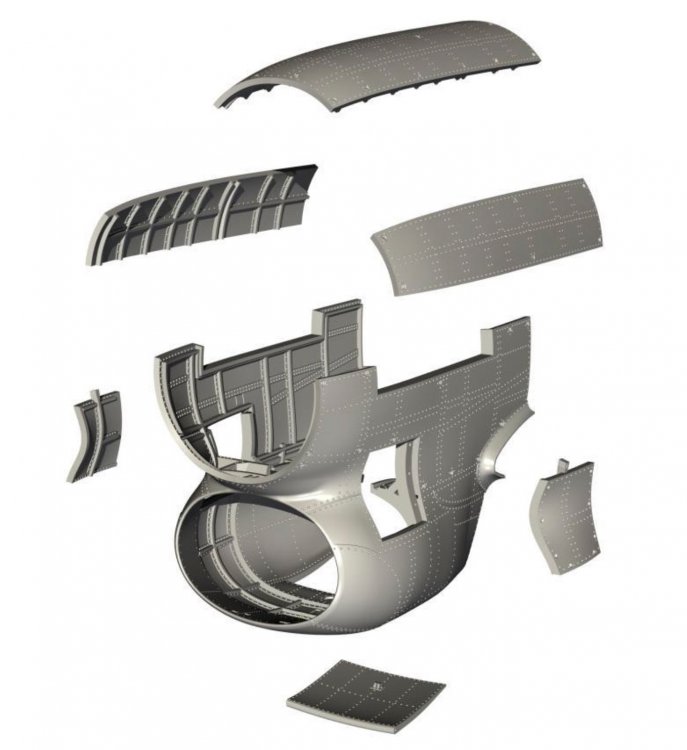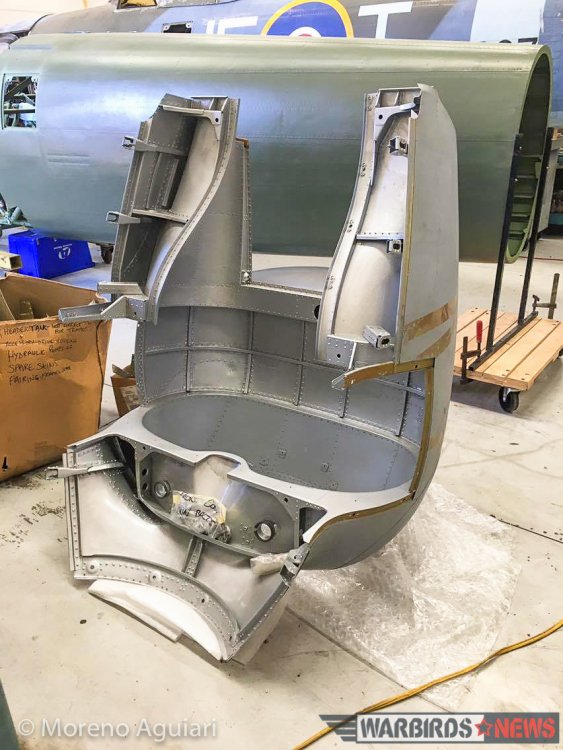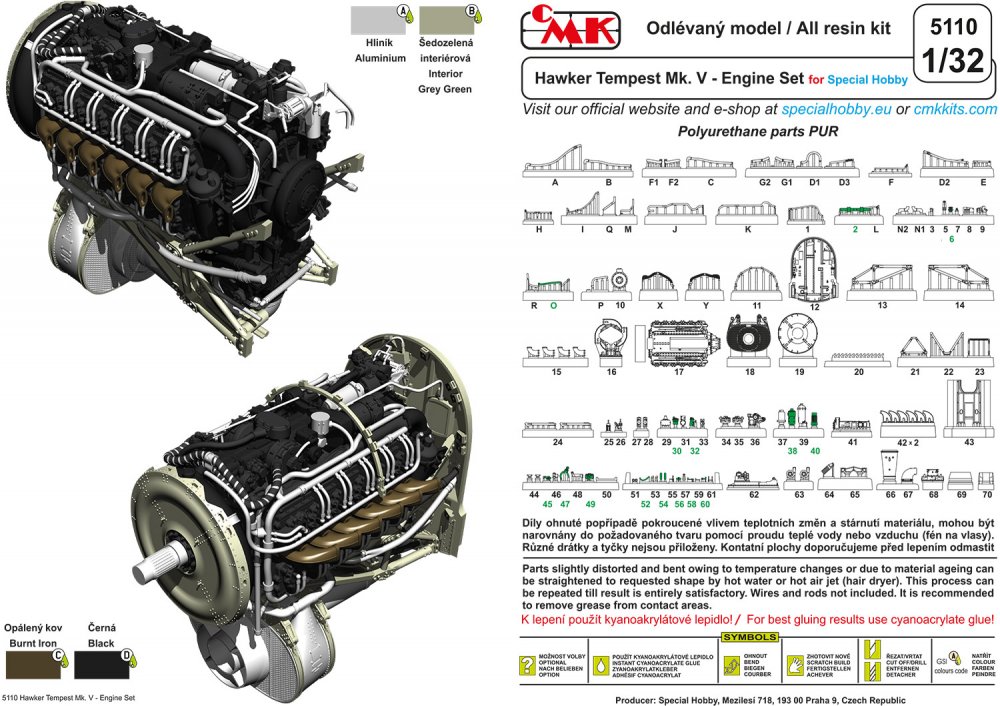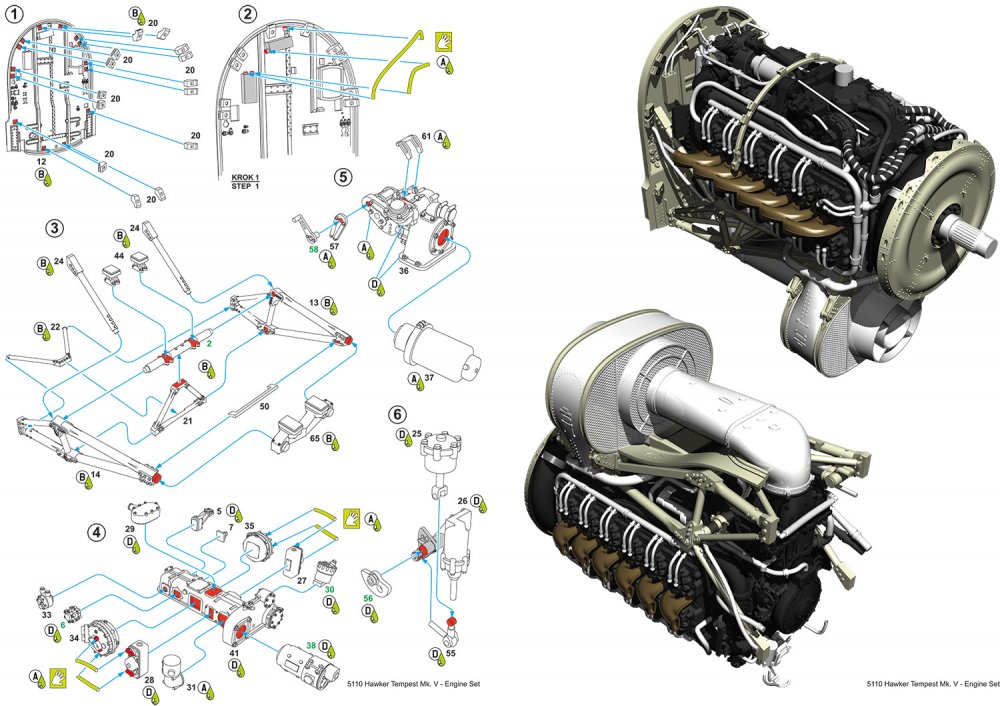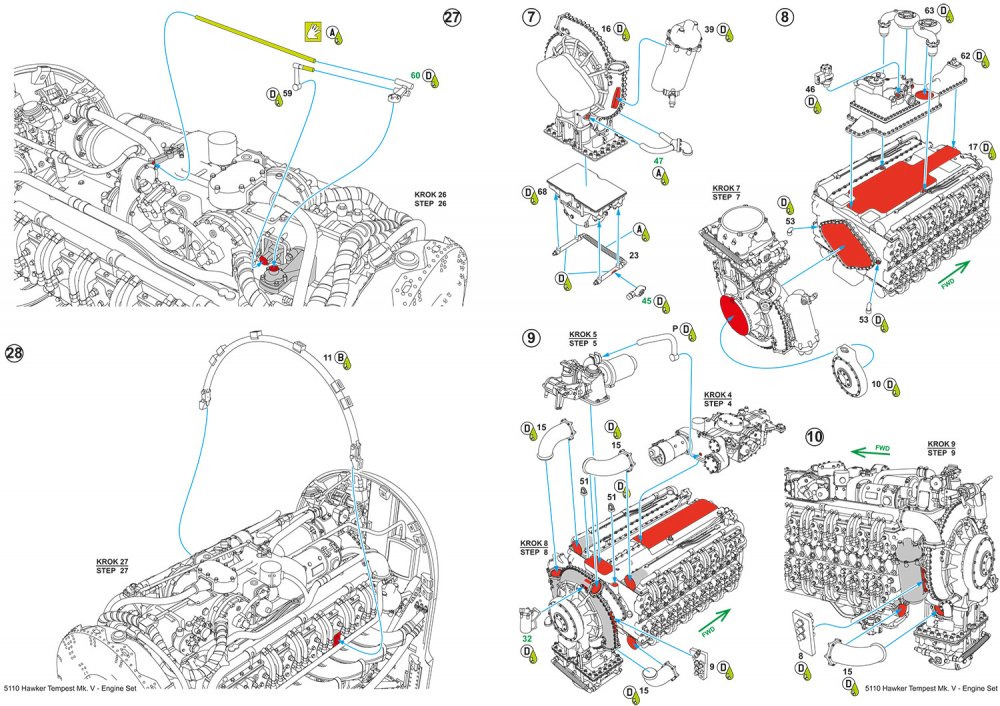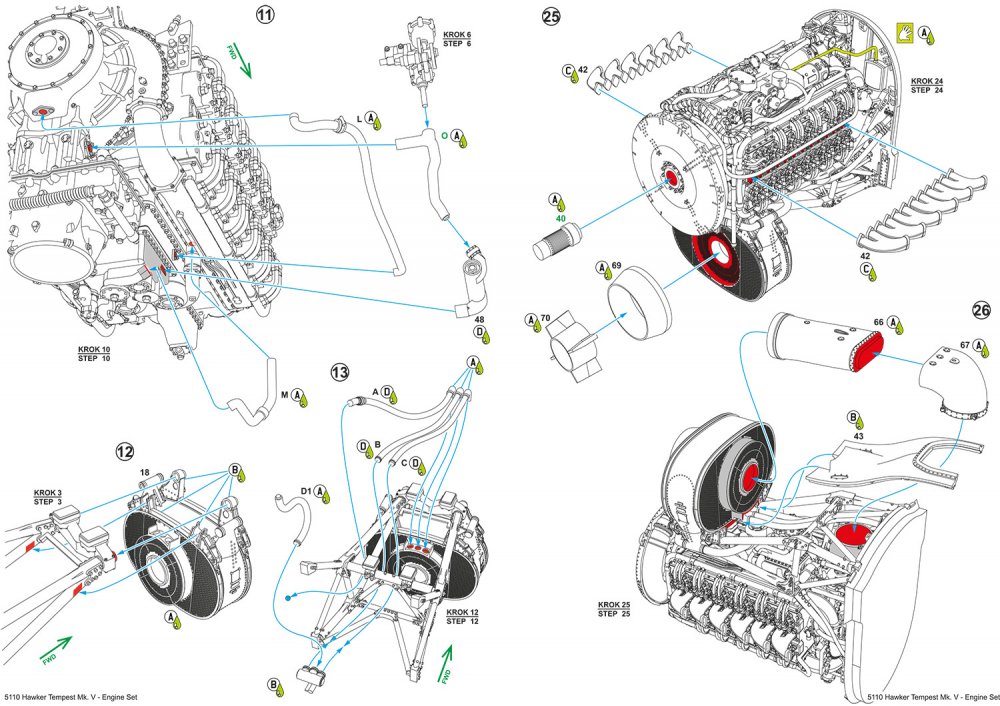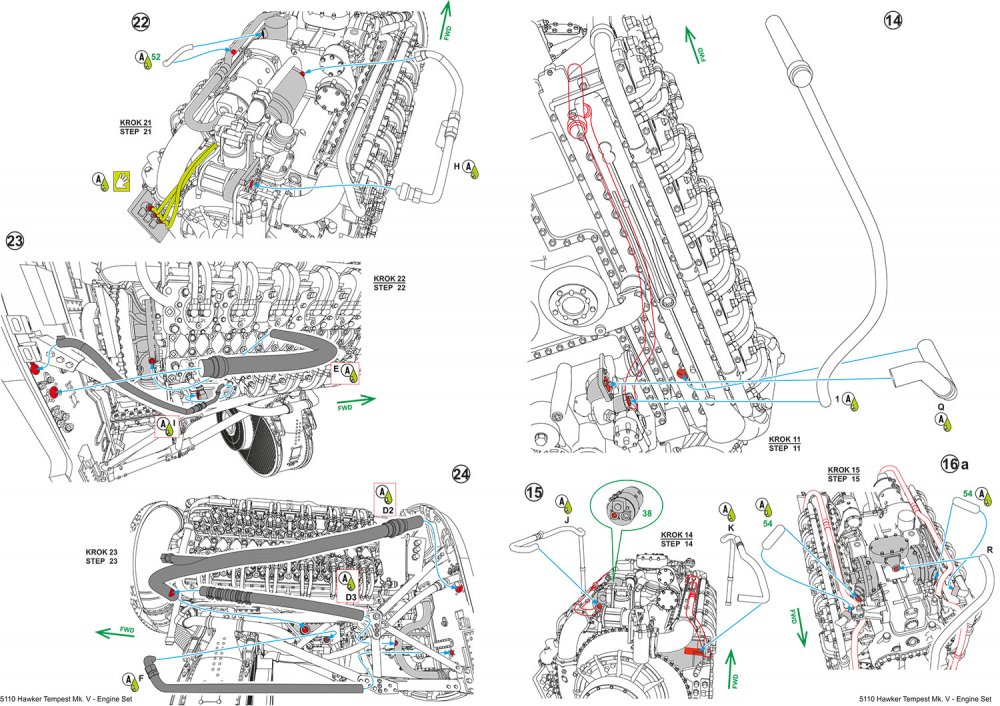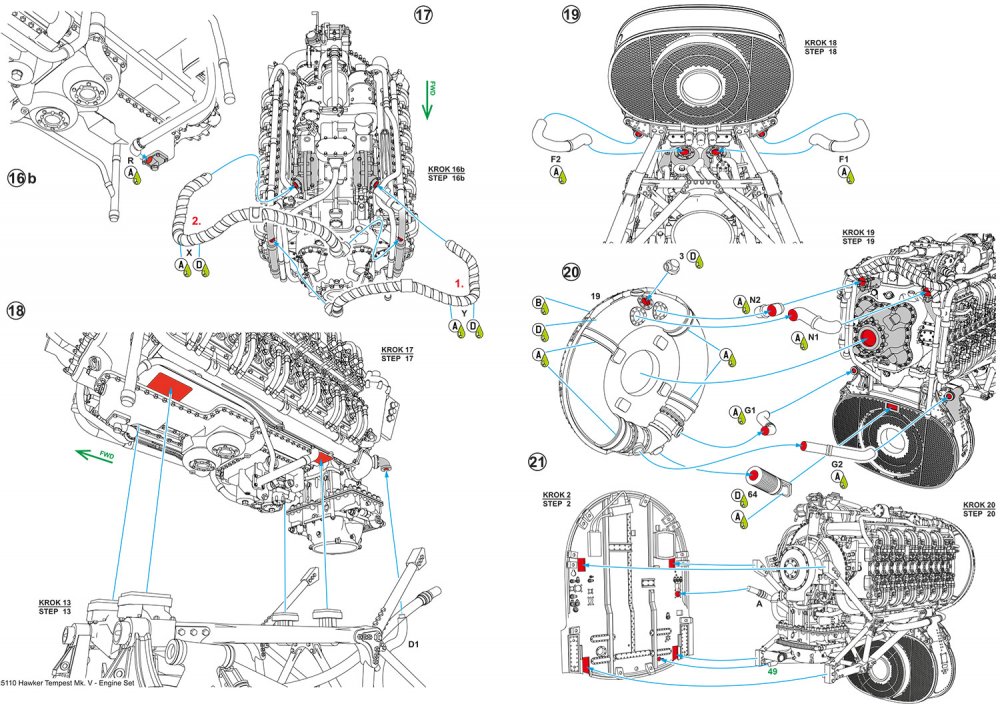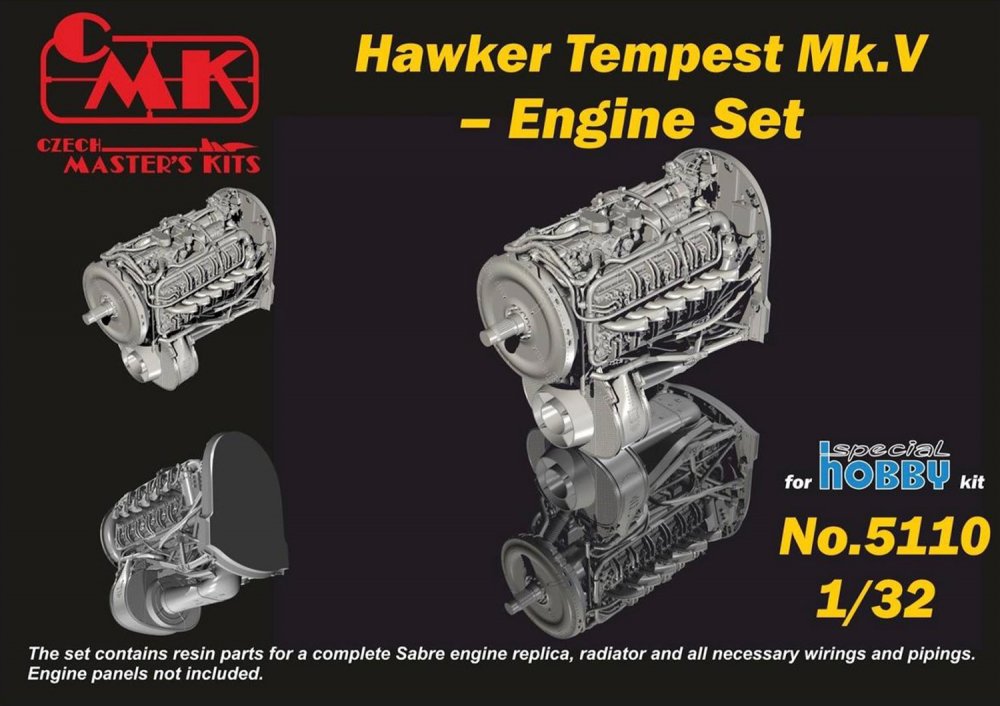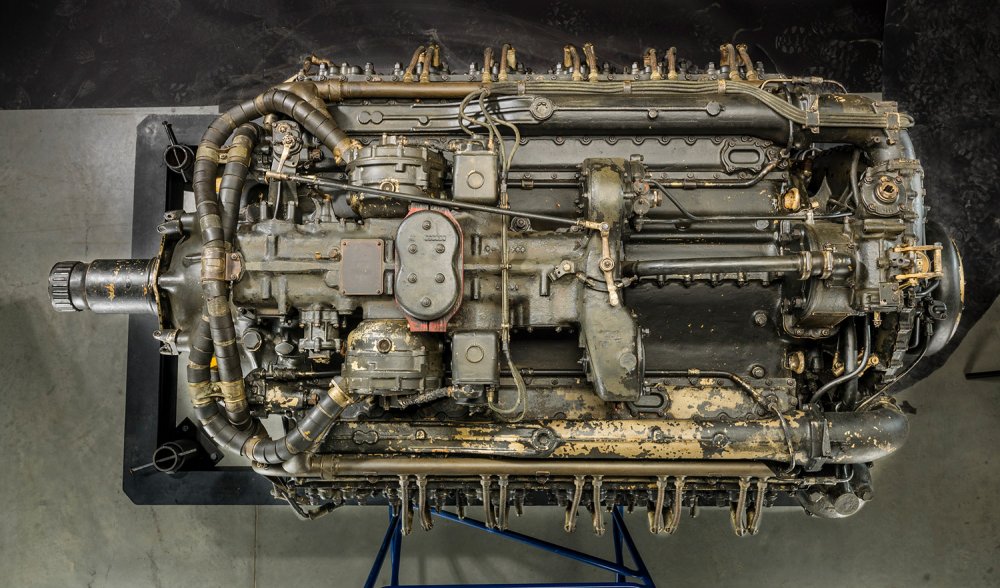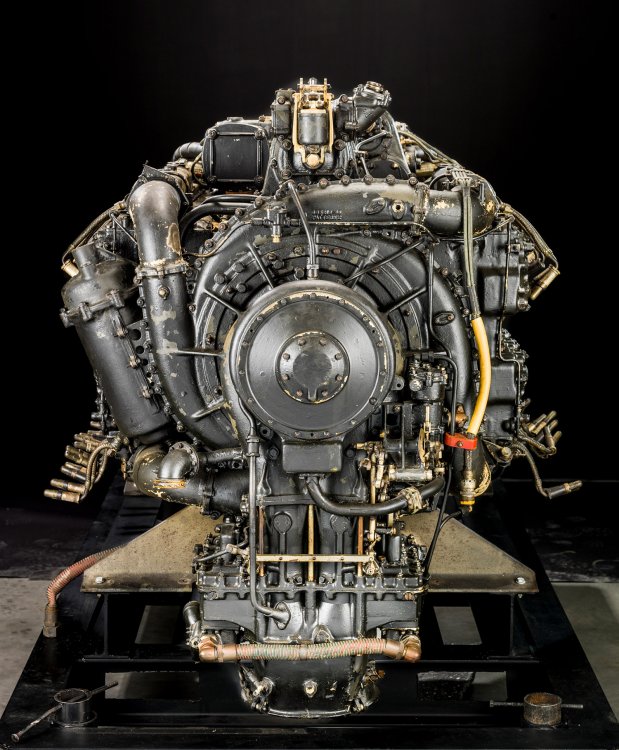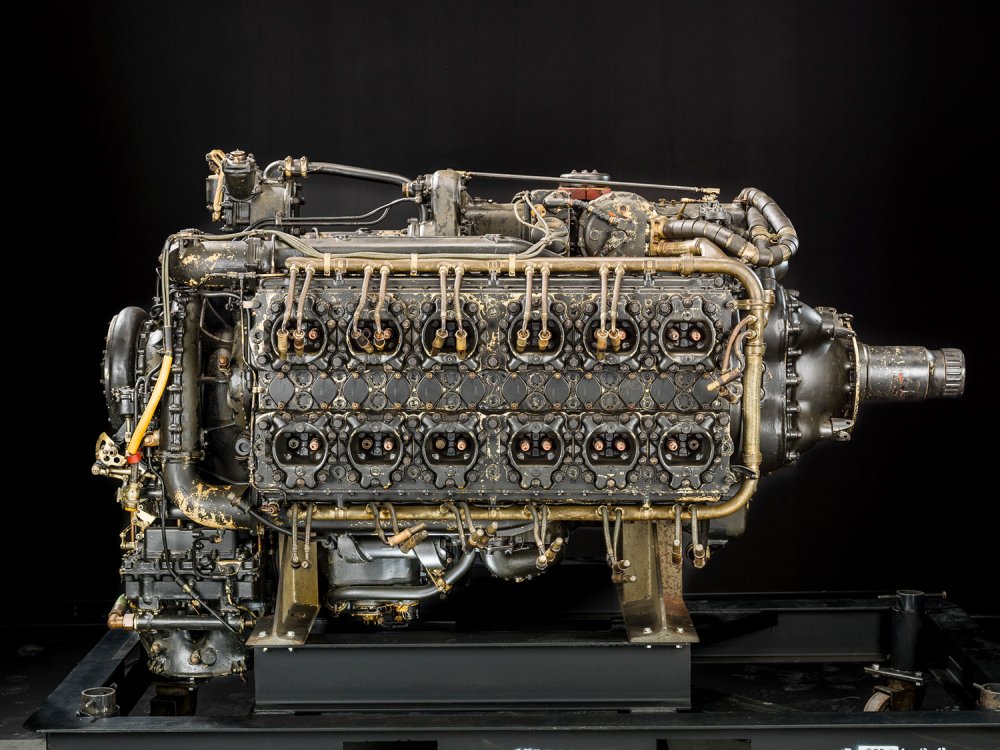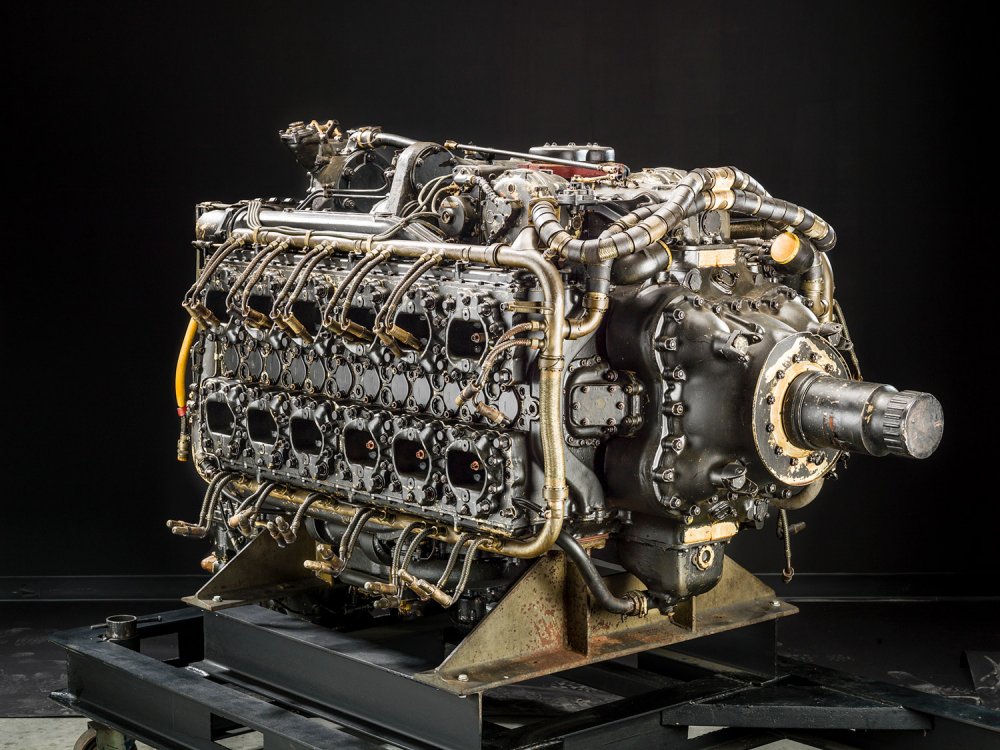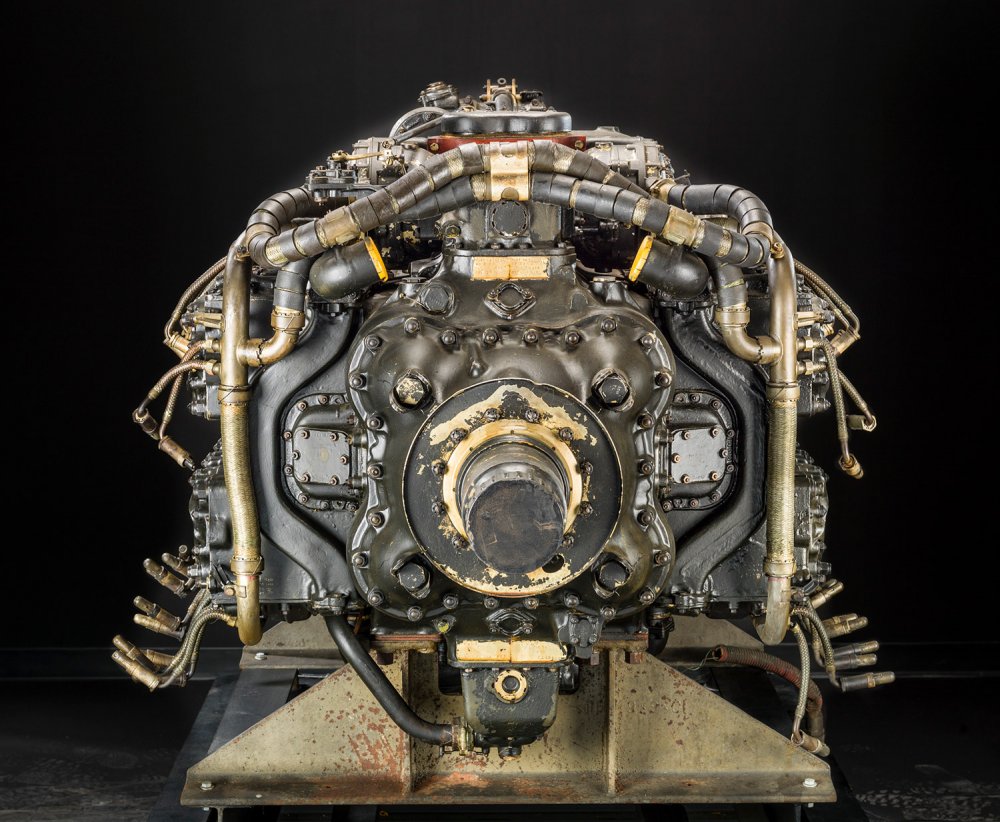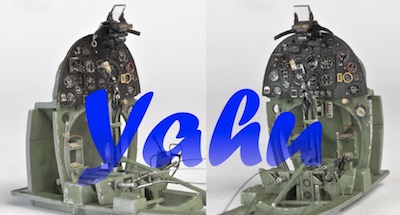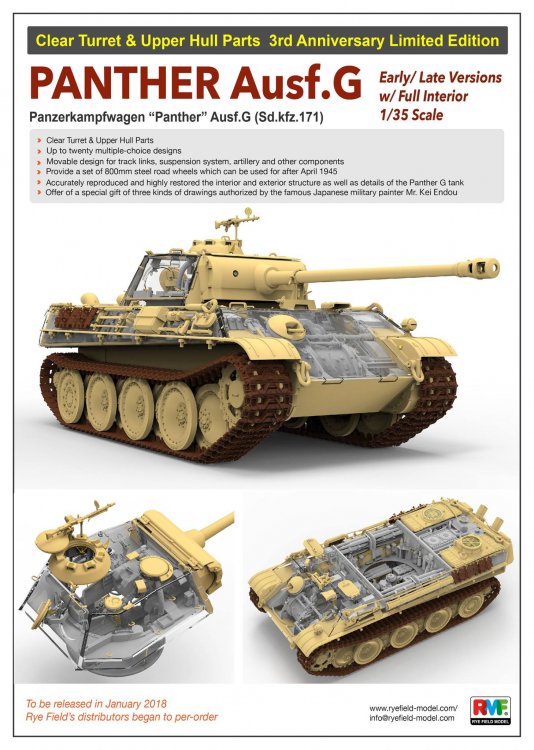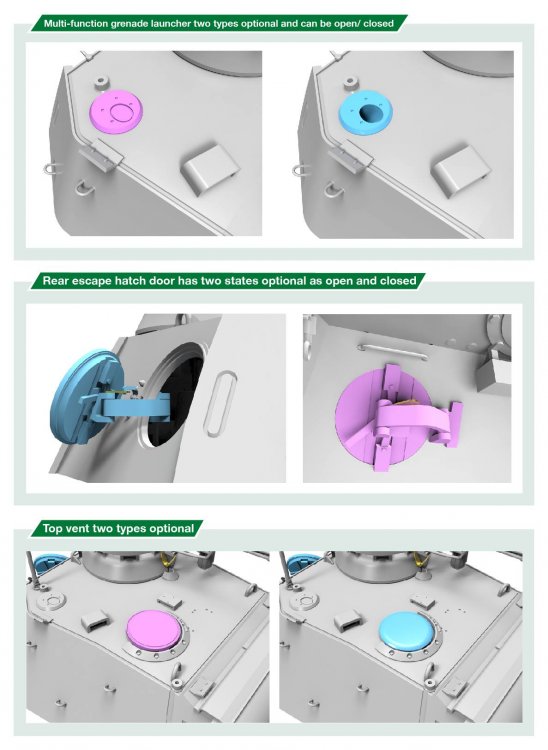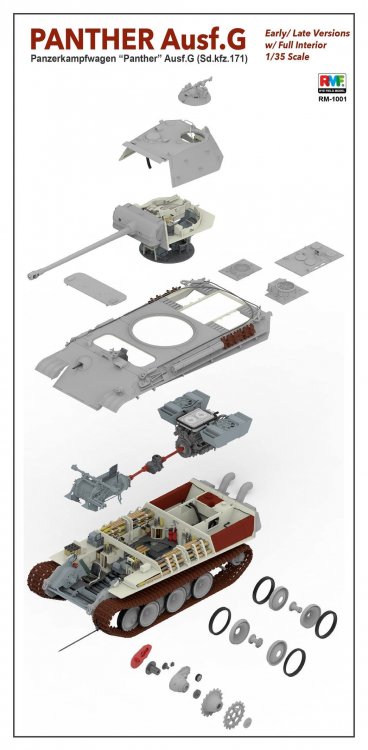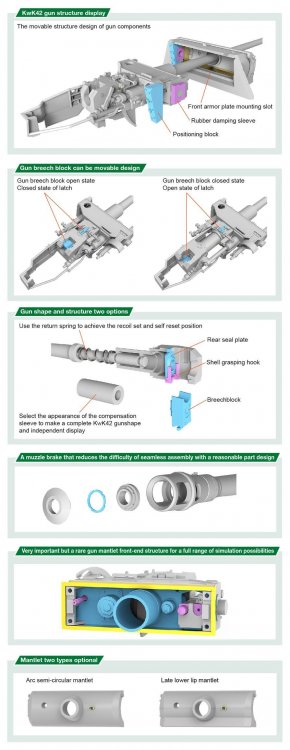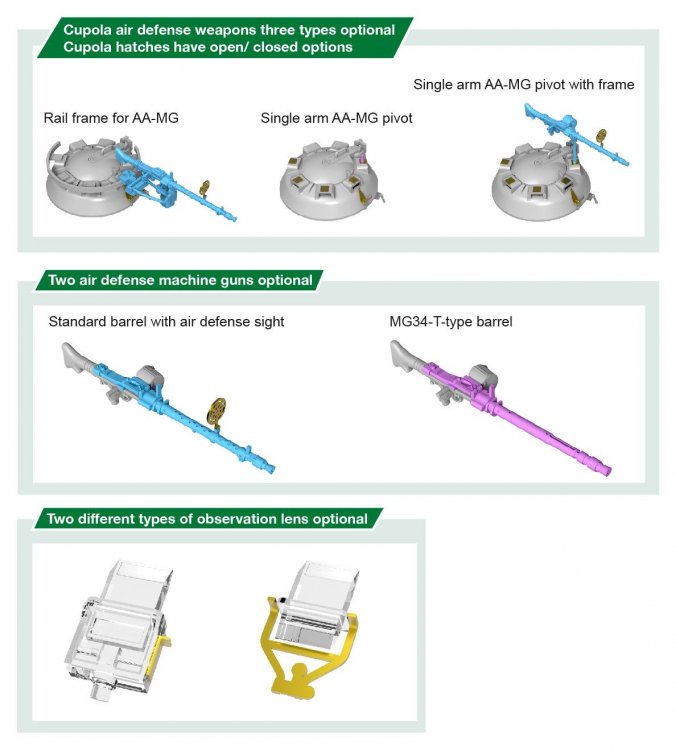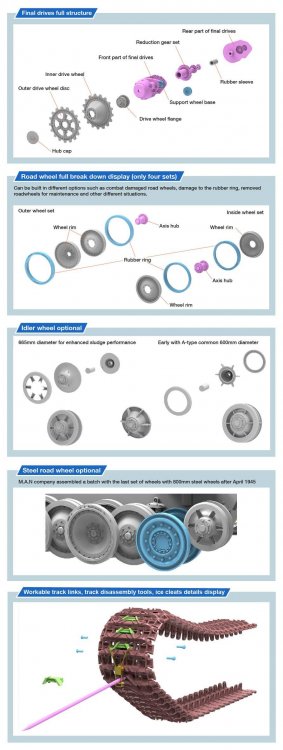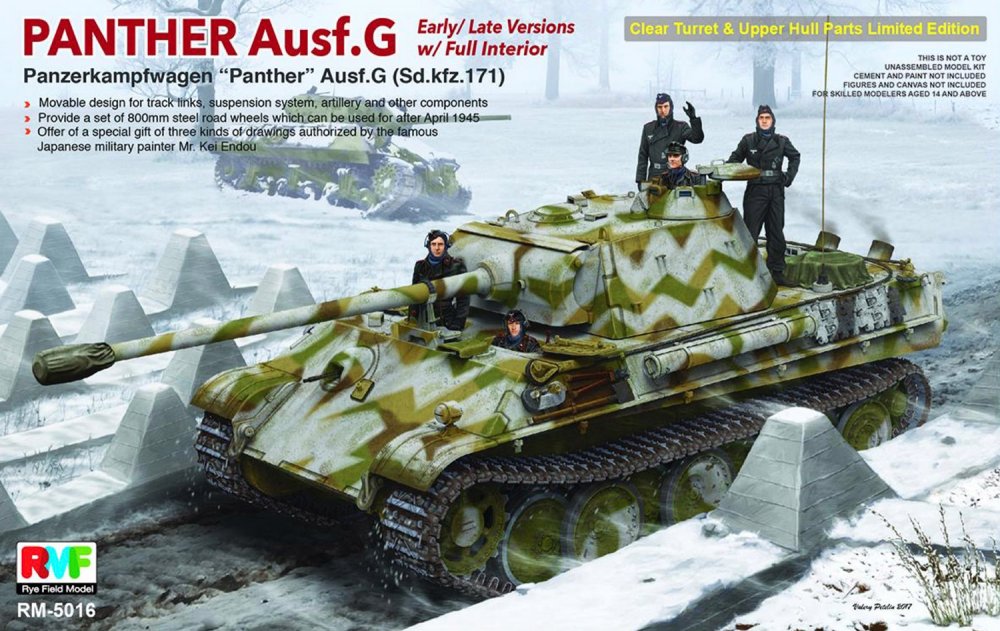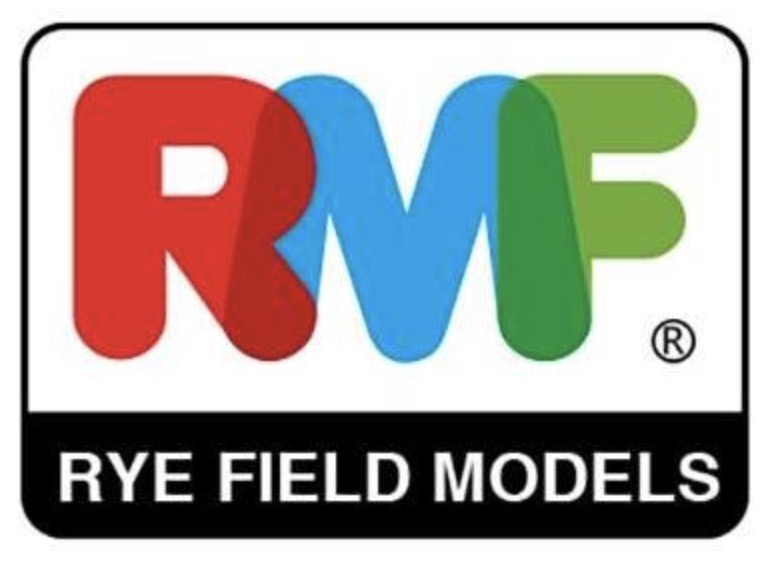-
Posts
3,255 -
Joined
-
Last visited
Content Type
Profiles
Forums
Events
Gallery
Everything posted by James H
-
1/35 Pz.Kpfw.VI Ausf.B King Tiger (late production) with full interior ICM Catalogue # 35364 Available for around £38.00 The Tiger II is a German heavy tank of the Second World War. The final official German designation was Panzerkampfwagen Tiger Ausf. B, often shortened to Tiger B. The ordnance inventory designation was Sd.Kfz. 182. It is also known under the informal name Königstiger (the German name for the Bengal tiger), often translated literally as Royal Tiger, or somewhat incorrectly as King Tiger by Allied soldiers, especially by American forces. The Tiger II was the successor to the Tiger I, combining the latter's thick armour with the armour sloping used on the Panther medium tank. The tank weighed almost 70 tonnes and was protected by 100 to 185 mm (3.9 to 7.3 in) of armour to the front. It was armed with the long barrelled 8.8 cm KwK 43 L/71 anti-tank cannon. The chassis was also the basis for the Jagdtiger turretless tank destroyer. The Tiger II was issued to heavy tank battalions of the Army and the Waffen-SS. It was first used in combat with 503rd Heavy Panzer Battalion during the Allied Invasion of Normandy on 11 July 1944, on the Eastern Front. The first unit to be outfitted with Tiger IIs was the 501st Heavy Panzer Battalion, which by 1 September 1944 listed 25 Tiger IIs operational. Henschel won the design contract, and all Tiger IIs were produced by the firm. Two turret designs were used in production vehicles. The initial design is often misleadingly called the "Porsche" turret due to the belief that it was designed by Porsche for their prototype; in fact, it was the initial Krupp design for both prototypes. This turret had a rounded front and steeply sloped sides, with a difficult-to-manufacture curved bulge on the turret's left side to accommodate the commander's cupola. Fifty early turrets were mounted to Henschel's hull and used in action. The more common "production" turret, sometimes called the "Henschel" turret, was simplified with a significantly thicker flat face, no shot trap (created by the curved face of the earlier turret), and less-steeply sloped sides, which prevented the need for a bulge for the commander's cupola and added additional room for ammunition storage. The Tiger II was developed late in the war and built in relatively small numbers. Orders were placed for 1,500 Tiger IIs — slightly more than the 1,347 Tiger I tanks produced — but production was severely disrupted by Allied bombing raids. Among others, five raids between 22 September and 7 October 1944 destroyed 95 percent of the floor area of the Henschel plant. It is estimated that this caused the loss in production of some 657 Tiger IIs. Only 492 units were produced: one in 1943, 379 in 1944, and 112 in 1945. Full production ran from mid-1944 to the end of the war. Extract from Wikipedia The kit This box is about the same depth as many other ICM kits that I’ve seen and handled recently, but it covers a larger footprint, with the box being quite wide. As is standard with ICM kits, the box itself if a rigid, corrugated type with a fold open lid which is locked into place with tongues and a tab. On top of this, the attractive and glossy lid shows a really good artwork of a King Tiger head-on, with its turret turned slightly sideways. I always think a good artwork sets the stall out for a kit. When I was a kid, it was the picture on the box that always grabbed my attention first. Inside the box, a total of TWENTY-TWO sprues are included, moulded in either light grey or black styrene. All of these are packed into two re-sealable clear sleeves. One sprue (A) is actually bisected into 3, to allow the parts to fit in the sleeve, and I have included those sections in the sprue count. Three sprues are simply the upper hull, lower hull bottom, and the new barrel that is specific to this release. In the bottom of the box is a 36-page A4 manual, a single fret of PE parts, and a small decal sheet. There are over 700 plastic parts in this kit, plus the 11 PE parts, so this will be welcome challenge in comparison with the previous ICM release of this kit which didn’t have an interior. That previous incarnation also had the dreaded vinyl tracks, but this new release has separate track links. Simply for ease of reference, here are all sprues and PE in this release, along with notes on how many are included. Sprue A Sprue B Sprue C Sprue D (x4) Sprue E Sprue F (x4) Sprue G Sprue H (x2) Sprue K Sprue L Sprue M Sprue N Sprue P Photo Etch Construction of this model begins with the interior of the Henschel turret. Now, I by no means think that whilst this kit claims to have a full interior, that it does actually have that. What I do think ICM has created here is a very good representation of the main elements of a full interior, but there are omissions that I can see, with my rather limited subject knowledge in this area. I recently purchased David Parker’s excellent book on the 1/16 King Tiger, and although David did super-detail his large-scale kit, it does highlight a few basic omissions in the ICM kit, such as the wooden roller that assists with ammunition loading, the side inner armour plates that flank the ammunition stowage area, and the TzF9B monocular scope. Having said that, ICM’s kit provides an admirable point from which to begin a similar, if somewhat less hard-core journey. The main elements within the turret are indeed there, such as the detailed loading block, main gun recuperator/recoil mechanism, 8.8cm ammunition racks, gunner and loader seats, etc. This kit has a new barrel too, and whilst the old one is still in situ on sprue E, it’s not to be used. Sprue G provides you with the part to be used. This is moulded as a single piece except for the muzzle brake and rear section. There is a faint seam on the barrel itself too. What is unusual about this model is the breakdown of the lower and upper hull. The upper hull is moulded with fenders in situ. Detail is very good with excellent weld seams, fasteners and bolts, plus the engine intake cooling intakes. It might have been an idea to have had extra open panel choices here to show off the interior, but the engine access panel is a separate part. As for clean-up, all there is to remove is the remains of the small moulding sprue that is located in the turret ring area. What is unusual about the lower hull floor is that the sides are moulded separately, whereas the rear plate is included in the floor moulding. The underside of the hull has superbly moulded access panels, and the interior detail ties nicely to those ports and also has the small standoffs for the torsion bars to sit upon. The Henschel turret is also nicely depicted and is moulded with the front section as a separate part, whereas the rear of the turret is in situ, minus the escape hatch. Again, weld seams are depicted with finesse, and the rear plate depiction is excellent, with the keyed joint. Hatches and cupola are separate. Something that this kit doesn’t have is clear parts, so any periscope details won’t have that proper glass appearance. A plastic grey plastic periscope ring is to be inserted within the cupola instead. Ideally, this will need painting black and then a high gloss to simulate the glass. You will notice another unusual engineering quirk in this kit, in that the swing arms are separate to the torsion bars, and these seems to be glued between the two hull sides, with the swing arms also being glued into position at a later stage of construction. So, unlike the likes of Rye Field Model, where you can have the choice of working torsion bars and articulated wheels, with this model, you aren’t given that option. That doesn’t mean that you can’t make these work as you may want. Looking at the parts, I think it’s feasible. Inside the hull, ICM has supplied the modeller with a very busy interior which you may still need to check out against reference for its level of completeness, but however, this area is still crammed with details. The rear hull has the Maybach engine, fuel tanks etc. all nicely detailed, and the intake fans are supplied in PE. All you need to do is to twist the fan blades into position and install them. Quite a nice touch. A detailed bulkhead separates the engine from the rest of the hull. Crew areas in this tank are nicely appointed, with transmission, drive and brake units all included, but there do seem to be some omissions, such as the radio set that took such a prominent position when looking at David Parker’s excellent book on his 1/16 build. No braided copper wire is provided in this kit for external cables. These are moulded in plastic. Also quite unusual are the various pioneer tools having their clasps moulded in plastic, despite the kit containing PE parts for other areas. It would have been good to have seen these are photo-etch parts. I’m pretty sure the tracks aren’t workable, but they do look easy enough to build. This appears to be something that needs to be done in stages also. Four sprues of black plastic contain all the parts for this. A single decal sheet provides all you need for the four schemes on offer here. This is well printed, being nice and thin and with solid colour and minimum carrier film. Everything is also in register. The schemes are: Pz.Kpfw. VI Ausf.B, s.Pz.Abt. Feldherrnhalle, Hungary, March 1945 Pz.Kpfw. VI Ausf.B, s.Pz.Abt. 503, Danzig, March 1945 Pz.Kpfw. VI Ausf.B, s.Pz.Abt. 501, Ardennes, December 1944 Pz.Kpfw. VI Ausf.B, Stab/s.Pz.Abt. 501, Ardennes, December 1944 A 36-page A4 instruction manual details the build over a total of 155 construction sequences, with paint references given for Revell and Tamiya paints. The illustrations are in line drawing format and are easy to follow. There shouldn’t be any ambiguity at all. The kit looks fairly easy to build despite the 700+ parts. A parts map is given at the front of the manual, showing those components not for use in this release. The last two glossy pages are given over to the colour schemes. Conclusion Whilst I really do like this release, there are other ways of creating a 1/35 King Tiger with a full interior, such as the Meng kit which requires their own aftermarket interior set, or with the Takom kit that has the interior included, they are both going to cost you more than this release. That could be up to twice the cost of the ICM kit. If you don’t want to include anything extra to what this kit offers, or you’re happy to do some scratch-building (and relish the extra challenges), then this could well be the kit for you. For a kit that can be bought for £38 (and I have seen it for around £5 less than that), then ICM’s kit represents good value for money and will build up into a very detailed model. The lack of any clear parts is a little disappointing too, especially when ICM has gone to the trouble of creating quite a nice addition to the armour market. In all though, this is a very reasonable release and could really provide the basis for an excellent rendition of the King Tiger. Recommended My sincere thanks to ICM for providing this kit for review.
-
1:48 Do 17Z-7 ICM Catalogue # 48345 Available for around £28 The Dornier Do 17 was designed as a lightweight, fast bomber that could, in theory, outrun any attempts by fighters to shoot them down. The long thin fuselage of the aircraft led to its nickname of ‘flying pencil’, and its shoulder mounted wing carried two engines, whilst its tail design was of twin fin/rudder arrangement, typical of that on the Bf 110. Initially powered by inline Daimler-Benz/BMW engines, but these were changed in favour of two Bramo 323 radials. A crew of three were carried, and up to 1000kg of bombs could be carried internally. Civil War in Spain saw the first baptism of fire for the Do 17, operating with the Condor Legion. Many of these pilots were unknowingly honing their skills for future operations against Poland, leading to the start of WW2, and eventually to the skies over Britain in 1940. It was here that the Do 17 became seriously outclassed by British fighter defence. The main version was the Do 17Z, which is the subject of this kit. The Z-7 variant had a solid nose that contained four forward-firing MG17. The last remaining, mostly intact Do 17Z was recovered from the waters off the Kentish coast and is not being preserved at RAF Cosford. The kit At the time of writing, this is the third incarnation of this 1/48 release from ICM, with this being the first Z-7 variant thus far. ICM’s style of packaging is probably one of my favourites, with the kit being supplied in a one-piece, sturdy corrugated cardboard box with a locking tab, and a separate product lid which sits over this. The glossy lid depicts a single Do 17Z-7 at dusk, in a simple but evocative image. This scheme is also shown on the box side. In fact, there are two schemes with this release, but they are nigh on identical, with only the fuselage code being slightly different. As Henry Ford once purportedly said, regarding his Model T car, “you can have any colour as long as it’s black”. Well, it is a night fighter after all. Inside the box, a total of six light grey sprues are packaged into a single re-sealable clear wallet, and a clear sprue is also slipped into there, protected within its own sleeve. In the bottom of the box, a 20-page A4 instruction manual is to be found, with a small decal sheet tucked within it. This release contains no photo-etch parts, instead leaning on companies such as Eduard, should you want to detail your model further. This certainly helps to keep down overall costs. Sprue A You can certainly see why this aircraft was called the flying pencil when you look at the fuselage halves. This was supposed to be the very essence of the Schnellbomber, but alas, the Do 17 was easy prey whilst undertaking that particular role. The characteristic fuselage is moulded with an open belly for the various loadouts or fuel tank assembly (the latter, for the purpose of this kit), and of course, the upper fuselage is open due to the shoulder-mounted wing that will be fitted here. For the tail-plane, the traditional slots are included on both port and starboard. ICM has created some very fine external detail in the way of panel lines and various access ports and panels. These are both very narrow and even in depiction. They should take a wash beautifully. Note that the airframe is devoid of any rivet detail, leaving a blank canvas for those of us who wish to add this. Internally, the fuselage doesn’t have any detail to speak of, but instead location holes and slots for the separate detail parts. One thing I really do like about this release is the rib and fabric depiction of the control surfaces. This is superbly rendered and doesn’t look at all exaggerated. All control surfaces are separately moulded, and you will find them here, as well as the stabiliser and fin parts. It is worth mentioning too that the Z-10 nose cone is also still on this sprue, as is the clear part (Sprue E) for the infrared detector for target illumination. Without delving further, I’m not sure if a Z-10 can be made from this release, but it does look pretty favourable. All the parts do seem to be here, including bombs (Sprue D) for the Z-2 version, plus the glazed nose (Sprue E). It appears that only the inclusion of the Z-7 nose and the decals are what makes this is a Z-7 release. Other parts you will find here are the fuselage bulkheads and two bomb bay door options (both open or closed). A small number of parts are slated as not for use in this release. Sprue B Only three parts here. These are for the full-span upper wing, and two lower wing panels. You will note that the ailerons are moulded separately, but the landing flaps are integral and not poseable without either aftermarket or with some surgery and scratch-work. ICM has designed the wing so the gear bay openings are moulded into the lower panels, with some rudimentary, corresponding interior detail on the underside of the upper wing panel. The nacelles and the remainder of the detail is separate. Externally, that detail is very neat, with thin and uniform panel lines and port details This model is not riveted, and for me, that leaves things looking pretty bare, so I will add the various rivet and fastener lines when it comes for me to build this kit. Sprue C Parts here mainly concern the engine nacelles and main gear interiors, plus the general internals for both the cockpit and bomb bay. A two-piece fuel tank is found here, moulded with its support straps. This will occupy half of the bomb bay. For the main gear bays, left and right walls are supplied, with moulded structural details, and also forward and rear bulkheads. The idea here is that these will be installed to the wing, complete with the retraction units for the main gear, and then the nacelles are built around these. Looking at the instructions, I do think that the retraction units can be fitted later, or at least I think so (don’t quote me!), making overall assembly and painting easier. Bar a couple of small parts, everything on this sprue is for use in this release. In amongst the numerous parts, you’ll find a lot of components for the cockpit, such as the two-part instrument panel, consoles, seats with their lattice weave, pilot floor and rudder pedals, control stick, avionics, machine guns, etc. Sprue D (x2) This sprue is supplied twice and deals with those items for which multiples are needed, such as the engine, cowls, propeller, spinner, main gear wheels, mudguards, oleo struts, engine bulkheads and mounting frames etc. Bombs are also found here, but these aren’t for use with the Z-7, as are a couple of MGs and saddles, plus the bomb mounting racks. The engine is excellent, and comprises an exhaust system for which separate manifolds and stubs are included. ICM has chosen to depict their wheels without any load, so you will need to sort the weighted appearance yourself. A few seams lines here and there on parts, but nothing out of the ordinary. Sprue E If you hadn’t already guessed, this is the clear sprue, and it is identical to all previous incarnations of this kit, including the glass nose. There are also two different greenhouse canopies included, with only one slated for use with this particular kit release. For use here are the clear blister and separate armoured windscreen that fit to the main greenhouse, as well as the clear parts for around the nose, that will be painted over, and the lower gondola glazing. Transparency is excellent, with reasonably thin, distortion-free plastic that has no visible or unsightly patina. Framing lines are nicely depicted and those frames are frosted. Full marks. Sprue F This small sprue contains one part for the Z-7 nose, complete with nicely moulded apertures for the forward firing MG. No detail is moulded within the nose, and no guns are supplied to fit within this, so to complete this as would be seen, some scratch work will be required, plus a trip to your spares box for the guns and ammunition bins/feeds. This kit does include the MG stubs for you to fit into the apertures. Decals Decals for this release are very basic by nature, with enough for two slightly different schemes. Printing is nice and thin, with solid colour and minimal carrier film. Everything is also in register. No stencils are supplied, but decals are included for the instrument panel. The two schemes in this kit are: Dornier Do 17Z-7, R4+HK, I./NJG2 Dornier Do 17Z-7, R4+FK, I./NJG2 Instructions This is a rather nice 20-page A4 publication with the schemes printed on the glossy cover, and the construction sequence within, broken down into 81 stages. Illustrations are by means of both shaded and line-drawn images, with paint references given throughout for both Revell and Tamiya colours. Conclusion I quite like this release as it gives plenty of detail out of box and still leaves areas to improve further, should you wish to. ICM are surely one of my favourite players in this hobby, releasing the sort of subjects that cry out for my attention. You may have seen their Ju 88 kits reviewed here, both in their own label and under names such as Special Hobby and Revell. Quality is excellent, my experience so far shows their kits to fit superbly. This really isn’t an expensive kit and provides amazing value for money in an age where everything seems to be getting more expensive by the day. I’ve always wanted a reasonably large scale Do 17, and now I have one. I’m certainly not disappointed! Highly recommended. My sincere thanks to ICM for supplying this kit for us to review.
-

Special Hobby 1/32 Fokker D.II “Black & White Tail”
James H replied to JeroenPeters's topic in Aircraft Reviews
Looks a lovely kit. Great to see companied like these tackling the lesser-known subjects. Great review and moist photos! -
1/32 IAR-80A Azur-Frrom Catalogue # AZUFR8002 Available from Special Hobby for 1300 Kč (approx. £45 in UK) The IAR 80 was a Romanian World War II low-wing monoplane, all-metal monocoque fighter and ground-attack aircraft. When it first flew, in 1939, it was comparable to contemporary designs being deployed by the air-forces of the most advanced military powers. Production problems and lack of available armament delayed entry of the IAR 80 into service until 1941. It remained in frontline use until May 1945. In 1930, the Romanian government issued specifications for a new fighter. Although the government was not anticipating bids from its own aircraft industry, IAR produced several prototypes in response to the tender. A second contest was also fought between the newer IAR 14 and PZL P.24 designs, and once again the PZL design won a contract for another 50 aircraft. Although IAR's own designs had not entered production, they nevertheless won the contracts to build PZLs and Gnome-Rhone 14K engines under license. As a result of these and other license contracts the company had enough money to fund a design shop even, if its designs never saw production. Despite losing to PZL, an IAR design team led by Dr. Ion Grosu continued work on fighter designs. He was convinced that the low-wing design of the IAR 24 represented a better design than the PZL gull-wing design. Once again, the team studied the new PZL fighter looking to incorporate its best features into a new aircraft, and the result was the IAR 80. By April 1941 the Romanians were firmly in the German sphere, and as a result the Germans released more FN guns for their use. These were quickly installed, and the resulting 80A model finally mounted the original complement of six guns. Armoured glass in the windscreen, seat-back armour, and a new gun sight were also added at the same time, along with the newer 1,025 hp (764 kW) K14-1000A engine. The extra engine power proved to be more than the fuselage structure was designed to handle, and it had to be reinforced with a duralumin "belt" just behind the cockpit (in the first 95 A series aircraft built before the fuselage could be modified). Although the IAR 80A had a more powerful engine, the added weight of the guns, ammunition and armour plating reduced the top speed slightly to 316 mph (509 km/h). Nevertheless, the new model was clearly an advancement, and the A model replaced the earlier one on the assembly line starting with the 51st airframe. Eight of these had been completed in time for the invasion of the Soviet Union on 22 June 1941. FN guns remained in short supply, so throughout late 1941 and early 1942, guns were stripped from PZLs and observation aircraft for use in the IARs. Edit courtesy of Wikipedia The kit We’ve not exactly been endowed with 1/32 kits of this extraordinary-looking fighter aircraft, which is a real shame. When it comes to WW2 protagonists, I suppose we rarely look at participants in the south-east of Europe. Thankfully, with the foresight of Azur-Frrom, and with help from Special Hobby, the stunning IAR-80A is now with us in a real scale! Of course, this isn’t the first of the line from these companies, with two previous incarnations available from them as the IAR-81C, dating back to 2014. This isn’t a simple incarnation of the IAR-81C though. The fuselage and wings are indeed different. Inside the box, this kit is comprised of six sprues of light grey styrene and a single clear sprue. A packet of small clear parts, another of resin parts, plus a wallet with decals and PE, conclude the contents. Oh yes, an instruction manual too! The clear parts in this release are thankfully packed into a separate zip-lock wallet to protect them. The box for this is very attractive too, depicting an IAR-80A from Escadrila 47 Vanatoare, Grupul 9, after a successful combat against a Russian Yak. That’s also a very tight lid to lift from the box…cue package of parts on the floor when it finally comes apart! Sprue A This sprue is very similar to the previous IAR-81C releases, but not identical. I did believe that there were changes in the length of the fuselage on the IAR-81C, but this new kit has the fuselages at exactly the same length. However, there are detail changes around the cockpit opening, in the area to the rear of the opening. I also note that the wing on this seems to be in a very slightly different position to the previous release. Externally, detail is nice and refined, with subtle and even panel lines, with rivets only seen along those panel lines, and not in between. The stiffening strip which runs from the cockpit to the tailplane is also nicely defined, and with rivet detail. Louvre detail just in front of the cowl position, is also very nice, but open. Internally, cockpit wall detail is excellent and very sharp, with nicely defined stringers and former detail. Please note that as is typical of low-pressure injected kits as this, that there are no locating pins to help you align the parts, so care will be needed (i.e. tape one side and glue from the opposing side!). The rudder is separately moulded, and the stabilisers will fit via the traditional tab and slot method. Also on here are the parts for the engine cowl. This is moulded as port/starboard halves, plus the nose cowl ring. There is a very slight short shot to one of the flaps on the rear of a cowl half, but this will be covered by the PE parts that are supplied and help to improve this area. The propeller blades are also moulded separately here, as is the bulbous spinner. Sprue B Again, at first glance, this looks identical to the previous IAR-81C, but it isn’t. The span of this machine was shorter, and this can be seen in the wingtips on this kit. Everything else looks the same except for the fact that the centreline on this lower wing has no provision for the bomb rack that fits to the previous releases. That lower wing is a full-span part with some exquisite panel line and access port detail. As with the fuselage, rivets are only to be found alongside those panel lines and ports. For me, I will most certainly want to enliven the surface by adding extra rivet lines. The main gears wells are just that…..wells, and they are moulded into the lower wing. As is traditional, the upper wing panels are individual pieces, and exhibit some of the very finest in engraved detail that I have ever seen, and I really do mean that. I just hope they take a wash after paint! The wings are moulded without ailerons and landing flaps, and the remaining parts on this sprue cater to the latter and are moulded as upper and lower halves. The frame and fabric depiction is very nice too. As with the fuselage, there are no locating pins on any parts here. Sprue C This sprue is identical to that of the previous release, and contains the ailerons, stabilisers, elevators and rudder. All are traditional construction, i.e. halves, and moulding is very nice indeed with the same attractive fabric and frame rendition on the control surfaces as I noted on the landing flaps. There are a few ejector pin towers on the reverse side, and you’ll need to snip them off before construction. Sprue D Now, unlike the main airframe components with low pressure injection, these are very different in appearance insomuch as the parts are glossy and extremely sharp with no real flash. I came across this sort of thing on the Special Hobby Tempest kits. The reason for the different moulding technique is due to the nature of the parts with them being intricate and relatively small. A good number of the key cockpit parts are found here, such as the upper tub frame, footboards, multi-part instrument panel, seat sides, optional control sticks with both regular stick grip and spade types, forward instrument panel mounting frame and rear frame etc. Also to be found here are the parts for the engine exhaust, control surface horns, and individual engine pushrods...yup, you’re gonna have to apply them one by one, all TWENTY-EIGHT of them! That’s a little different from the regular approach of attaching them to a central hub. Sprue E The clear parts. Special Hobby have packed these into two little wallets, with the canopy parts in one wallet, and the gunsight lense and wingtip lights in another. Clarity is very good, with no visible distortion. Sprue F Another high-pressure moulded sprue here, with many main parts for the IAR K14-1000A engine. The front and rear radial banks are moulded as halves, and the details are excellent with fine cooling fin reproduction and cylinder head details. You will also find the hub here, plus the main exhaust hub section. It’s such as shame that the beautiful hub and its detail will be totally hidden by the shroud which sits behind the spinner, totally obscuring the aforementioned detail. Talking of spinners, the rear plate is moulded on this sprue. The main gear struts are found here, as are the wheels. There is no weighted effect to the latter, so you’ll need to sort that yourself or purchase the resin wheels from CMK. Hub details on these are very nice, but as they are integral to the wheels, you’ll need to mask them for airbrushing. No masks are included with this release. A couple of inner gear doors are moulded here but not for use, and you will also find a few remaining cockpit parts such as sidewall detail and the main seat part. Of note are a couple of parts here at the edge of the sprue, near the engines. The sprue here is cut-out and the delicate parts in that area have suffered some breakage and will need repair or re-fabrication. These parts concern the instrument panel mounting. Sprue G Here we have our last sprue, and this contains, amongst other things, a longer spinner version that that found on Sprue A. The instructions do state that either can be used, but you might want to look at reference photos of your specific machine before committing to either one. Other parts include replacement inner gear bay doors, alternative instrument panel section, under-cowl scoop, and two headrest parts as an alternative to the part on Sprue F. Resin parts Four casting blocks are supplied here, cast from medium-grey resin. Two of these hold the parts for the exhaust manifolds with nicely hollowed out ends, the engine intake and filter, and the last block holds a series of smaller parts. These are for the gunsight (two included), and the gun barrel stubs/muzzles. Casting is excellent, as you would expect from Special Hobby/CMK. Photo Etch This small fret contains the engine cowl louvres, multi-part pilot harness, interior canopy handle and elevator trim tab actuators. Again, production is excellent, and the belt details will look good under a coat of paint. Decals A single sheet, printed by Aviprint, contains decals for all national markings, serials, insignia, stencils and instrument panel gauges etc. Printing quality is very good, with solid and authentic colour, minimal carrier film and perfect register. The decals also look nice and thin too. There should be no error with these whatsoever as Radu Brinzan was involved with their design. I can certainly rest easy with that as Radu is the go-to guy when it comes to this machine. The four schemes supplied are: IAR-80A – “Anghel”, Escadrila 47 Vanatoare, Grupul 9, Pipera, August 1942 IAR-80A – Escadrila 53 Vanatoare, Mamaïa, July 1942 IAR-80A – “Felicia”, Escadrila 47 Vanatoare, Grupul 9, Pipera, Summer 1942 IAR-80A – “Mamy”, Escadrila 47 Vanatoare, Grupul 9, Pipera, Summer 1942 Instructions I quite like Special Hobby’s instructions format. They are clear, concise and the illustrations are easy to follow. This manual starts with a history of the type, followed by a parts map, indicating those components that aren’t to be used. Constructions is broken down into 24 stages, with clear drawings guiding the way, and the use of colour illustration to highlight painting and parts placement. The last pages of the manual contain the scheme illustrations, with good, clear scheme depiction and decal location shown. Conclusion After the IAR-81C, I was thrilled to see the earlier pure fighter version of this kit being released. It has a swarthy appearance and was, by all accounts, on par with the Fw 190A/F series in terms of performance. This is a superbly detailed kit, but perhaps one that needs just a little more attention and skill than your standard off the shelf kit, due to the main airframe components and the alignment and clean-up required. In all though, this is a superb kit of an important and oft-forgotten fighter type, and Frrom-Azue/Special Hobby (with Radu) have given it the attention it truly deserves. For the price, with both PE and resin, this is a very attractive package. All they need to do is fix the break in the sprue on F, that causes those two parts to fracture. Highly recommended. My sincere thanks to Special Hobby for sending out this review sample to us. To purchase directly, click THIS link.
-

Bu - 131 (ICM 1/32)
James H replied to Johann's topic in LSM 1/32 and Larger Aircraft Ready for Inspection
Fantastic! Any WIP? -
I really MUST get a copy and put it up for review here. David, would you be able to supply a small number of chosen pages for a review? I can watermark them too.
-

1/48 Wellington Mk.X (He727 NA-K)
James H replied to JeroenPeters's topic in LSM 1/35 and Larger Work In Progress
Slick looking PE work and nice call on removing that second pilot position.- 304 replies
-
- wilnis crash
- trumpeter
-
(and 1 more)
Tagged with:
-
1/35 Tiger I Middle Production Sd.Kfz.181 Pz.Kpfw.VI Ausf.E Rye Field Model Catalogue # RM-5010 The Tiger I is a German heavy tank of World War II deployed from 1942 in Africa and Europe, usually in independent heavy tank battalions. Its final designation was Panzerkampfwagen VI Tiger Ausf. E, often shortened to Tiger. The Tiger I gave the Wehrmacht its first armoured fighting vehicle that mounted the 8.8 cm KwK 36 gun (not to be confused with the 8.8 cm Flak 36). 1,347 were built between August 1942 and August 1944. After August 1944, production of the Tiger I was phased out in favour of the Tiger II. While the Tiger I has been called an outstanding design for its time, it was over-engineered, using expensive materials and labour-intensive production methods. The Tiger was prone to certain types of track failures and breakdowns and was limited in range by its high fuel consumption. It was expensive to maintain, but generally mechanically reliable. It was difficult to transport, and vulnerable to immobilisation when mud, ice and snow froze between its overlapping and interleaved Schachtellaufwerk-pattern road wheels, often jamming them solid. This was a problem on the Eastern Front in the muddy Rasputitsa season and during extreme periods of cold. The tank was given its nickname "Tiger" by Ferdinand Porsche, and the Roman numeral was added after the later Tiger II entered production. The initial designation was Panzerkampfwagen VI Ausführung H (‘‘Panzer VI version H’’, abbreviated PzKpfw VI Ausf. H) where 'H' denoted Henschel as the designer/manufacturer. It was classified with ordnance inventory designation SdKfz 182. The tank was later re-designated as PzKpfw VI Ausf. E in March 1943, with ordnance inventory designation SdKfz 181. Today, only about seven Tiger I's survive in museums and private collections worldwide. The Tiger 131 at the UK's Tank Museum, which was captured during the North Africa Campaign, is currently the only one restored to running order. The kit This isn’t a new release, but one from 2016 and the last of 5 Tiger variant releases from Rye Field Model. This time, RFM has concentrated their efforts of producing a mid-production Tiger I, and with a full interior. We recently reviewed their latest kit, the Panther G, whose review you can find HERE. The box for this kit takes up the same footprint as the recent Panther kit, but it about 20% shallower. However, this box is still crammed with plastic to the point where you need to put the parts back in the box in the same order as you got them out, or you’ll struggle to fit everything in again. The box lid has a superb artwork of No.217 (not Otto Carius due to the incorrect tracks) and this is one of three schemes available out of the box. Under a fairly airtight lid, you will find TWENTY-TWO sprues, moulded in either tan or grey styrene, and also a single-piece lower hull, clear box of track links, two frets of PE parts, PE Zimmerit tools, a single decal sheet, and braided copper wire. A few of the latter are packaged into a single clear sleeve, along with a mini-sprue containing just two parts moulded in tan plastic. Whilst not all sprues are bagged individually (identical multiples co-bagged), all parts are in perfect condition. That’s just as well when you consider that this kit has around 1000 parts! Oh, that doesn’t include the multipart track links either. More on that soon. Lastly, a 28-page colour-printed A4 instruction manual is also included. In all, this is quite a weighty package. The intention of this review isn’t to assess the accuracy of this kit, but instead to provide details of the contents and any options that are available to the modeller. As this kit is now over 12 months old, I will supply links at the end which will supply you with further information as to the accuracy and opportunities offered with this kit. Sprue A This tan-coloured sprue has a large hole in it where parts that are presumably from an earlier release, have been snipped out. Parts here are primarily centred on the multipart gun barrel (made from sections instead of the dreaded halves), turret and mantlet parts. There are actually three different mantlets here but only one (A3) is shown for use with this release. Another large and seemingly unused part is the turret lid. Instructions show one sprue Z as for use. So, some important useful parts for your spares box. Also to be found here are the stowage bins for the rear of the turret and the cupola. Sprue B Some large superstructure parts to be found here, including the upper hull with the larger cooling air intakes moulded integrally. Of course, PE screens are included for these. One of the TWO options for the rear hull plate are included here, catering for the different equipment and exhaust layouts. Also found here are pioneer tools, equipment boxes, various braided ducts/hoses for the Feifel air filters, stowage boxes and the ends of the towing cables with their crimps, and the vertical plate with driver’s vision port and MG position. Sprue C (x2) These two sprues contain all of the road wheels. As this wasn’t one of the retrofitted steel wheel machines, the rims on these were rubber. The manufacturer and wheel size can be clearly read on the rims. Detail is superb, with excellent hex bolt details on the hubs. Circumferential seams are non-existent, but of course, the sprue gate attachments will need to be eliminated. I always find this easiest when the wheels are paired together. Sprue D (x2) Here we have the drive and idler wheels, transmission gear housing, torsion bars and swing arms etc. The torsion bars will work if you make a slight adjustment to each one. There is a small plastic tab on these that locks them into a single position, but removal will make the swing arms move. Ideal for those dioramas. Sprue F There are more unused parts on this sprue, such as alternative side hull walls and yet another mantlet, plus the lower side front hull where the transmission gear housing fits. With the latter, refer to unnamed sprue for the parts we will use with this release. What we will be using, however, are the fenders, engine cooler intake doors, front shelf that sits below the driver’s vision port, and also brackets for the spare tracks which will fit to the turret side. These are moulded as a curve, so you can create the assembly properly before it’s fitted to the turret. Very nice design… Sprue H Moulded in a medium grey styrene, this sprue contains parts for the Maybach engine, petrol tanks and other associated rear hull internals. Sprue J Another grey sprue, appearing to mostly if not exclusively, containing parts for the turret internals. Again, some parts are not for use, such as the internal turret ring and the turret floor. The parts to be used are to be found on Sprue U. Sprue K The genius in me has worked out that all interior parts (generally) are moulded in grey, as we now look at a sprue which contains the Tiger’s transmission, driver compartment parts, disc and steering brake units, wireless radio, bulkheads and firewalls etc. One side of my sprue is curved in through stress, but no damage to parts can be seen. Sprue M (x2) Every tank needs ammunition and here you will find the main gun shells and ammunition pouches for the MGs. Sprue N (x4) These for sprues are moulded in dark grey styrene and are all concerned with track construction. Each link it built from 5 pieces, and here you will find the track pins that are moulded in blocks of four. These are designed to stay on their mini-sprues until after you have inserted them to the tracks and added cement. Only then do you clip the sprue from the assembly. The other track parts are the horns (2 per link). These are going to be seriously tedious to assemble, so patience will be required. Each of the Sprue N has a section of jig which will fit together for you to assemble reasonably log runs of track per time. Sprue O Here we have the 22T jack, external pioneer tools, and jerry cans, which actually fit within the turret! It looks like some parts here aren’t for use, such as an alternative rear turret stowage bin. Sprue S This tiger is moulded with a single piece external turret, but the internal turret details such as the viewing ports, will be fastened to a two-part interior shell that fits inside the exterior once the main turret assemblies are completed. Internally, there isn’t any real detail on the walls as internal stowage, if any, was fitted to the inner rim/floor of the turret. Sprue T The only clear sprue in this kit, containing the various periscope parts etc. Clarity is excellent, and everything is beautifully sharp. Sprue U This grey styrene sprue contains more engine parts and the alternative internal turret ring and floor which should be used with this release. Photo Etch P & V Produced as PE are the engine intake cooler screens, internal hull frames, pioneer tool clasps, etc. To properly identify PE parts in the instructions, I wish RFM had inked them in a different colour to differentiate from the styrene parts. PE quality is excellent, with narrow gates to snip through to remove parts. Photo Etch Y These are the Zimmerit tools, and four different ones are provided. The tooth pitch is the same on all of them, but the scraping faces are different lengths. Those verticals will need to be cut separately, of course. Unnamed Sprue This contains only two parts, and is to be found in the bag containing the decals and wire etc. There are parts which form the front of the lower hull sides, where the transmission gear housing fits. Sprue Z Here we have the slab sides of the tank hull, turret lid (the one that will be used), alternative rear hull panel, two cupola options (both can be used), mantlet (not to be used with this release), engine access door and various external detail parts. Lower Hull A superb single-piece moulding with fine internal and external details. Internal ejector pin marks seem to be placed where the various pieces of equipment will be installed, and if you really want to remove them, they are only superficial. Welding seam reproductions are exquisite, and this is a triumph of slide-moulding technology with beautiful, sharp details on all surfaces. One thing I do note is that the external port detail on the underside rear of the hull, don’t match the port details on the inside. This shouldn’t matter though as the Maybach engine will completely obscure the erroneous details. Tracks (x192) These are supplied in a clear plastic box and are moulded in dark grey colour plastic and are attached in strips of 12, with two small connectors between each one. Moulding really is very nice, but you will need to fit the horns yourself, plus those pins, creating 5 parts per track, and with 96 links per side, that equates to 475 parts for the tracks alone! Patience, Padawan! Cable A single length of braided copper wire is included with this release, listed at 45cm in length. Decals Just a single sheet here for all three schemes. Printed by Cartograf, these are beautifully thin, contain minimal carrier film, and are in perfect register. Colours are nice and solid, and the finish is matt. The three schemes in this release are: No.217, February 1944, Eastern Front No.342, Early Spring of 1944, Belgium/Mons No.321, June 1944, Northern France Instructions I’m a real fan of RFM’s instructions format. This manual is A4 in size, has 28-pages and printed in full colour. The first pages provide a parts map, but no shading for unused parts. Unsually, the next pages contain the three schemes. These are usually found at the rear of a manual. The profiles are said to be provided by Mig’s AMMO, as are the paint references. If you use anything other than that brand, you will need to source your own paint reference codes. Next, various internal assemblies are shown in colour for your painting reference, and then a Zimmerit map which shows the various faces which need to have putty added. I do admit that I’d like to have seen a moulded Zimmerit option, but hey ho! The rest of the manual has the Tiger broken down into 37 constructional sequences, but don’t let that fool you as most sequences are broken down further. Colour again features throughout, not only with more colour subassembly illustrations, but also shaded parts which define parts attachment. The last pages show more colour illustrations of the interior of the Tiger. Conclusion I purchased this kit whilst on a weekender in York, in between the various fine real ales and green tea Lattes, but it wasn’t on a whim. It was only a few weeks earlier that I’d reviewed the brand new Panther Ausf.G, sent to me as a sample from Rye Field Model, and the detail hooked me instantly. A decision was made to pick up the slightly older kit if I ever came across it, and so I did. This one cost me £59.99 at Monk Bar Models, and it was the best money I spent that weekend (next to the real ale!). I’m certainly not disappointed. The superbly detailed full interior, intricate external details and superb engineering. I’m still a little daunted by the prospect of adding Zimmerit myself, having never done this before, but I suppose I need to start learning some armour techniques if I’m to diversify a little. I also find the tracks a little daunting too, with the 5 parts required per link, including the pins, but RMF’s trick of adding them whilst on the sprue and then snipping the sprue from them, is genius. In all, a seriously nice package that I’ll need to restrain myself from starting, until at least the Panther is built. Very highly recommended Review kit courtesy of my wallet and the fine folks at Monk Bar Model Shop, York. Tell them you saw the review on Large Scale Modeller!
-

hong kong models Dornier Do 335A-12 Trainer
James H replied to James H's topic in LSM 1/35 and Larger Work In Progress
...beast -

1/48 Wellington Mk.X (He727 NA-K)
James H replied to JeroenPeters's topic in LSM 1/35 and Larger Work In Progress
.....and he's off! I'll be disappointed if you don't build the entire geodetic fuselage from PE.- 304 replies
-
- 3
-

-
- wilnis crash
- trumpeter
-
(and 1 more)
Tagged with:
-
Please try now.
-

hong kong models Dornier Do 335A-12 Trainer
James H replied to James H's topic in LSM 1/35 and Larger Work In Progress
Still just playing around with dry fit at the moment due to some work I'm doing on an ICM 1/32 I-16, but I still couldn't resist. Such a cool airplane. The lines really do it for me. Note the wing spar boxes in the wing, still seen because I haven't attached the leading edge sections. -
Awesome! Hope you publish more armour here. WIP?
-
1/32 RP-3 60lb SAP/HE British WWII Rocket Projectile Special Hobby Catalogue # SH32075 Available from Special Hobby for 267 Kč (approx. £10) The RP-3 (from Rocket Projectile 3 inch) was a British rocket projectile used during and after the Second World War. Though primarily an air-to-ground weapon, it saw limited use in other roles. Its 60 lb (27kg) warhead gave rise to the alternative name of the "60 lb rocket"; the 25 lb (11.3kg) solid-shot armour-piercing variant was referred to as the "25 lb rocket". They were generally used by British fighter-bomber aircraft against targets such as tanks, trains, motor transport and buildings, and by Coastal Command and Royal Navy aircraft against U-boats and shipping. The "3 inch" designation referred to the diameter of the rocket motor tube. The rocket body was a steel tube 3 inches (76 mm) in diameter filled with 11 pounds (5 kg) of cordite propellant, fired electrically. The warhead was screwed into the forward end and was initially a solid 25 pounds (11 kg), 3.44-inch (87 mm) armour-piercing shell which was quickly supplemented by a 6-inch-diameter (152mm), 60 pounds (27 kg) high-explosive head. Another type of head was a 25 lb (11 kg) mild steel (later concrete) practice head. Once the rocket had been mounted on the rails, an electrical lead (or "pigtail") was plugged into the exhaust of the rocket. Four large tailfins induced enough spin to stabilize the rocket, but as it was unguided aiming was a matter of judgment and experience. Approach to the target needed to be precise, with no sideslip or yaw, which could throw the RP off line. Aircraft speed had to be precise at the moment of launch, and the angle of attack required precision. Trajectory drop was also a problem, especially at longer ranges. On the plus side the rocket was less complicated and more reliable than a gun firing a shell, and there was no recoil on firing. It was found to be a demoralising form of attack against ground troops, and the 60 lb warhead could be devastating. The rocket installations were light enough to be carried by single-seat fighters, giving them the punch of a cruiser. Against slow-moving large targets like shipping and U-boats, the rocket was a formidable weapon. The kit As if loading your Special Hobby 1/32 Tempest kit with resin cockpit parts, undercarriage and wheels, resin engine, gun bays and cowls wasn’t enough, then another very nice set comes along to tempt you further and helping to create one of the ultimate Tempest kits available. This time we have a set which addresses an omission in the original standard and HI-TECH releases of SH’s Tempest kit; namely the rocket ordnance. Of course, these weapons won’t be limited to just the Tempest release, with several WWII types also carrying them, such as the Typhoon, Swordfish, Hurricane, Beaufighter, Thunderbolt and Mosquito, to name a few. Just make sure that the rails/mountings are suitable for whatever type of aircraft you fit them to. This new set is packaged into a reasonably large but shallow box as is befitting a complete, single sprue. Moulded in a light grey styrene, this sprue is further protected by a clear film sleeve. Also within this sleeve are the instruction sheet and a small decal sheet. This set contains enough parts to build EIGHT RP-3 rockets, including their mounting rails, which as I’ve mentioned, are likely profiled to fit onto the Tempest kit. Each rocket is made up from a single-piece body with half of the warhead moulded in situ. The other half being a separate part. The four fins are also separate, but the mounting lugs to the rails are a part of the rocket. Lastly, the rail. The rail is moulded to the mounting points which you may need to modify if you don’t fit these to the Tempest. Moulded detail looks to be commensurate with the many photos of these that can be found online. The only compromise being a solid connection between the rocket instead of the spring-loaded clip that was used in reality. This is also the way Airfix tackled the subject for their superb 1/24 Typhoon. I seem to recall that the only other way of representing such intricate details is with metal, as per the Master 1/24 series. However, these are still very, very good and that detail doesn’t detract. Moulding quality is superb, with all details being sharp, and nothing in the way of visible seam lines. No flash or defects are present. The single decal sheet contains decals for both the A/C3” SAP 60lb, and the A/C3” HE 60lb types. Printing is my Aviprint, and the inks are in yellow and red, with the text being readable and fine. Registration is also perfect, and the printing is thin, with minimal carrier film. A single folded A4 sheet is provided for the instructions. As you would imagine, these aren’t difficult to construct, and the illustrations clearly show everything you need to know. Colour codes are provided for Gunze paints, and the rear of the instructions shows the rockets in colour, providing details for both warhead load-outs. Conclusion A nice and simple set that provides that beautifully detailed RP-3s for your project. The only thing you would need to add are the pigtail fuses that fit into the rear of them. In this scale, I would use the thicker EZ-Line which naturally sags under its own weight. Simple to build and with some nice decals to finish them off, these should look great under the wing of the recent 1/32 Tempest, and I’ll be adding them to my future project for Military Illustrated Modeller magazine. Highly recommended. My sincere thanks to Special Hobby for the review sample seen here. To purchase directly, click THIS link.
-

hong kong models Dornier Do 335A-12 Trainer
James H replied to James H's topic in LSM 1/35 and Larger Work In Progress
Do I have your permission? -
Dornier Do 335A-12 Trainer, 'Anteater' Hong Kong Models Well, it had to happen. Not that I'm complaining whatsoever, but despite building the previous incarnations of this beautiful kit, I am now embarking on my THIRD! This time though, it's my all-time favourite version, the two-seat A-12 'Anteater'. I will be building this model for Military Illustrated Modeller, but I will also be posting it here too as it's good to show a wide audience just what this will look like when complete. The HKM Do 335 actually fits together great, and isn't fussy. Nor do they have that god-awful clear plastic for the main parts, and they aren't naturally tail-sitters. The engineering is straightforward and fuss-free. There are some areas which would benefit from a little extra help, and I'll use some Eduard for those. I'll even shoehorn a Yahu instrument panel into the front office. As for the finish, well I think I'll be sticking with what was known, which is the green splinter with metal cowls and undersides. Not really wanting a what-if for this build. The kit itself, of which I have some test shot parts, is almost the same as the previous versions, save for a sprue with a different spine and internal parts, plus a set of car parts for the instructors office that sits higher up. This sprue isn't quite the finished thing, as there are a couple of short-shots on the rear seat stirrups. That's easy to fix. There are also no part numbers applied yet, but that isn't going to be a problem. Whilst I will be building this with the bomb bay doors closed due to being a trainer machine. There is no emphasis on this in delivering an explosive payload. Now, where I really am torn is in posing the panels. This machine looks best with everything closed, but I may leave a rear engine panel open, and maybe the forward cockpit. I really don't want to ruin the lines. Pretty sure at this point that the front engine will be entirely closed up. At the moment, all I have is a test-fitted fuse with the key internals dry-fit together. So.....here we go!
-
1/32 Focke-Wulf Fw 190C (V18) Känguru Conversion for Hasegawa A5/A8 kits Planet Models Catalogue # PLT233 Available from Special Hobby for 1079 Kč (approx. £38) Whilst there is no doubt that whilst Kurt Tank’s Fw 190A series was highly successful, it’s real Achilles heel was its lack of performance at high altitude, whereas its biggest contemporary and competitor, the Bf 109, was a far more capable performer. This lead Tank to look at ways of addressing the altitude performance problem early in the program. In 1941, he proposed a number of versions featuring new power plants, and he suggested using turbochargers in place of superchargers. Three such installations were outlined; the Fw 190B with a turbocharged BMW 801, the Fw 190 C with a turbocharged Daimler-Benz DB 603, and the Fw 190 D with a supercharged Junkers Jumo 213. The aircraft would also include a pressurized cockpit and other features making them more suitable for high-altitude work. Prototypes for all three models were ordered. The C model's use of the longer DB 603 engine required more extensive changes to the airframe. As the weight was distributed further forward, the tail of the aircraft had to be lengthened in order to maintain the desired centre of gravity. To test these changes, several examples of otherwise standard 190As were re-engined with a supercharged DB 603 to experiment with this engine fit. These were the V13 (W.Nr. 0036) with the 1,750 PS 603A, the similar V15 and V16, with an 1,800 DB603E being fitted to the latter after a time. With this engine, the V16 was able to reach 450 mph at 22,310ft, which was a considerable improvement over the 400 mph at 17,060ft of the basic A models. V18 followed, the first to feature the full high-altitude suite of features, including the pressurized cockpit, longer wings, a 603G engine driving a new four-blade propeller, and a Hirth 9-2281 turbocharger. Unlike the experimental B models, V18 had a cleaner turbocharger installation, running the required piping along the wing root, partially buried in the fillet, and installing both the turbocharger air intake and intercooler in a substantially sized teardrop shaped fairing under the cockpit. This "pouch" led to the "Känguruh" (Kangaroo) nickname for these models. V18 was later modified to the V18/U1, with a "downgraded" 603A engine, but a new DVL turbocharger that improved the power to 1,600 PS at an altitude of 35,105ft. Four additional prototypes based on the V18/U1 followed: V29, V30, V32 and V33. It is the V18 which is perhaps the most interesting, and the subject of this conversion set review. The kit Planet Models’ Fw 190C/V18 ‘Känguruh’ conversion set is packed into a reasonably large box, as befits the full fuselage replacement that it contains. The box lid has a large sticker with a product label attached, showing a rather sleek-looking 190C. This is quite a nice angle to see this at, as other angles would show the aircraft to be a little clunky in places, but still a very interesting aircraft in the evolution of the 190 series. Whilst it is generally said that the Fw 190D-9 was the aircraft that went on to be the genesis of the Ta 152 development, the Fw 190C, with its wide-chord fin, is also said to be an important step towards what was to become perhaps Germany’s most impressive piston-engine fighter. As stated on the label, this conversion contains fuselage halves, exhausts, main gear wheels, coolers, propeller, vac-form sliding hood, and decals. You will of course need a Hasegawa Fw 190A-5/A-8 kit which will donate its wings, cockpit, gear struts, stabiliser etc. All components within this conversion are packed into heat-sealed sleeves, with the fuselage halves being separate items in themselves. It’s these parts that I’ll be looking at first. The overhaul of the fuselage on the 190C/V18 was so extensive that it required an entirely new fuselage. As with the original kit, these are supplied as halves, and they pretty much exhibit the same standard of detail that is seen on the original kit parts. By this, I mean fine panel lines and port access details. There is no riveting. When I come to build this, I will river the whole airframe, including the wings and this new fuselage replacement. The instrument coaming and forward upper fuselage areas are cast integrally with the remainder of the fuselage. You can clearly see the wing root fairing into which the turbocharger pipework will recess, as well as the intake that sits below the annular radiator. The tail fin is also wide-chord, as with the Ta 152, yet the fuselage isn’t extended as was seen on the 190D series, despite the length of the nose. Presumably the intake under the bellow helped to offset the change in the centre of gravity. Also note that the rudder is cast separately. Internally, there is no detail as this would come from the Hasegawa cockpit parts. There is a very small stub on the underside of the fuselage, which is a remnant of the casting block, so this will be a breeze to remove. Other parts in this release include the long turbocharger pipes that tuck under the wing root fairings and exhaust further down It doesn’t appear that the wing root gun bay wing-moulded detail needs to be modified, so all looks good there! Of course, there is the large intake which sits below the belly of the 190, in P-51 style, and there is a small section of plumbing which needs to be fitted here, stretching to the fillet that separates the main gear bay. There is a new part which fits between the bays, and to fit the large intake itself, some plastic will need to be trimmed from the belly plastic that is moulded to the rear of the main, lower wing panel. It all looks quite simple to execute. A small intake grille fits within the belly intake, as does a separate part that fits into the nose intake area. That belly intake is provided in halves, so there will be a seam to remove, as with the fuselage. This machine was designed to be armed, and although there appears to be no wing guns, the fuselage ones were still installed. Evidence of this is shown on the forward nose cowling, where the gun ports are actually found, unlike other 190 series where there were channels on the upper cowls for this purpose. With the 190C, the cowl changes meant that these were now embedded within the cowls due to the change in depth of the nose. Note also how angular the nose cowl is, unlike the large curved radius of the A-series machines. This gives the 190C quite an unusual appearance. Radiator details are cast within the main nose ring cowl. Of course, a new 4-blade Hirth propeller is included, along with a new spinner, again giving a highly unusual feature for the 190. A set of main gear wheels are also supplied to replace the Hasegawa plastic. Resin quality is very good, with everything being cast in an unusual shade of grey. Where casting blocks remain, then they will be easy to remove. Where they are already removed, then final clean-up will just consist of removing a resin tag or thin resin web. There is a little flash to remove in places, and a slight scratch will need to be buffed out on one fuselage half. Many people dislike vacform parts, but that’s what you have here for the pressurised cockpit rear hood with its canopy framing. Planet Models supply TWO canopies, just in case you make a mistake, but they really aren’t as difficult as you’d imagine. To cut these, I fill the interior with Blue-Tack which makes the part more rigid. A brand-new scalpel blade is used to cut the plastic, with Dymo tape being used as a guide. It would only take a few minutes to complete this task. Vacform clarity. No masks are supplied with this release, so you’ll need to mask it using your own methods. Lastly, a single, small decal sheet is supplied for the V18 prototype. This consists of the national markings, split swastika, and prototype codes. A couple of small stencils are included for the wings. You may need to supplement this with kit stencils, but I don’t know if this would be historically accurate. Printing is excellent, with the decals being nice and thin and having minimal carrier film. Registration is void because the decals are either black or white, with no multicolour elements. Two A4 instruction sheets are supplied and folded into A5. A history of the 190C is supplied, and a photo of the parts, with identifier numbers. Twelve black and white images are included which shows construction of the model, along with notes as to which resin part is which. Annotation clearly indicates the Hasegawa plastic. When it comes to sawing and modifying the plastic, you will need to measure things yourself as no dimensions are supplied. Conclusion For me, this is a very exciting conversion set in that it really recreates a transitionary and evolutionary change between the A and D versions, and Tank’s attempt to push the metaphoric envelope with his design so it could be operated at high altitude. There’s no doubting the historical significance of the C-series birds, despite them not really being at the forefront of our attention, or indeed print articles etc. Planet Models has created a rather nice set which should easily convert the Hasegawa Fw 190A-5/A-8, and as this is quite a simple conversion, it should be ok for those who have limited but some resin experience. All in all, an excellent and relatively inexpensive conversion set. Highly recommended My sincere thanks to Special Hobby for the review kit shown here. To purchase this directly, click THIS link.
- 2 replies
-
- 3
-

-
- conversion
- fw 190
-
(and 2 more)
Tagged with:
-
Really odd. We seem to have had a major problem with permissions. If you notice anything else, please let us know.
-
Please can you try now?
-
1/32 Tempest Mk.V – Engine Cover Panels (for Special Hobby kit) CMK Catalogue # 5111 Available from Special Hobby for 801 Kč (approx. £28 in EU. Other countries may vary) If you’ve not already taken a look at our review of the Tempest V Engine Set, designed for Special Hobby’s rather sweet kit, then click HERE to get an idea of what this set should accompany. Whilst it’s entirely feasible to build the engine and Tempest without the cowl parts, you will of course need the engine if you plan to buy this product. As far as I know, Special Hobby has no plans (as yet) to release the two sets together, but maybe watch out and keep your eye on their schedules. Cowl photo courtesy of Warbirds News This new release (still showing as ‘coming soon’ on their website on 26-2-18) comes in one of CMK’s familiar yellow, flap-opener boxes that are typically used for their more parts-numerous detail sets and carrying a label which shows the contents in their CAD form. Inside this box there are two bags of light grey resin, and a folded A5 instruction sheet. One of these re-sealable bags contains a single resin piece; namely the large, lower chin cowl that also forms the lower circumference of the spinner area. This part is connected to its casting block at the front, with thin resin webs and the fill veins attaching themselves to the spinner and radiator opening part. This was the best way that such a complex part could be cast and there really shouldn’t be any problem with its removal. A deep tongue extends from the casting block, into the void within the main radiator housing. This simply appears to be a mechanism to give some rigidity to the mould when casting. The detail on this part is incredible, with all constructional elements within being minutely captured. It does appear that this isn’t at all designed to be fitted to the host model unless you seriously modify the engine set. I get the impression that this is designed to be used to display alongside the main mode, in a form of maintenance diorama, or simply to show the cowls on the model’s base. Externally, the detail is representative of the host kit, with fine panel lines and riveting. You will need to be super-careful when it comes to the protruding cowl fastener locations, as these look fairly fragile. Our second bag of resin contains nine further pieces which comprise the upper, side upper and side cowl panels, as well as the small panels for the glycol tank access, the radiator shutter and the lower rear panel which meets up with the bully of the Tempest. As with the other part, the interior details are faithfully recreated, including the strengthening strip rivets, which nicely align with the external rivet details, which are of course tiny divots as per the host airframe. Casting blocks are connected with those thin webs and pour veins and will be easy to remove. There’s not really much to say about the instruction sheet, save for the fact it identifies the various panels. Curiously, it shows the various panels being assembled into a hollow sheel, which of course isn’t how you’d pose these. Some text does say, however, that these would just be scattered around whilst the Tempest is in maintenance. Resin casting quality is as good as it gets, with no flaws or distortion in these thin panels. Conclusion Accompanying the engine set, this is a set that is most worthy of your inclusion when your Special Hobby Tempest V hits the workbench. I’m not too good at dioramas, so would simply opt to place these adjacent to the completed model. The interior structures are interesting and worthy of the not insignificant investment that both this and the engine wold cost. Very highly recommended My sincere thanks to Special Hobby for the set seen in this review. To buy directly, click THIS link.
- 2 replies
-
- 1
-

-
- special hobby
- engine
-
(and 2 more)
Tagged with:
-
1/32 Hawker Tempest Mk.V – Engine Set (for Special Hobby kit) CMK Catalogue # 5110 Available from Special Hobby for 1.964 Kč (approx. £68 in EU. Other countries may vary) The Napier Sabre was a British H-24-cylinder, liquid-cooled, sleeve valve, piston aero engine, designed by Major Frank Halford and built by D. Napier & Son during World War II. The engine evolved to become one of the most powerful inline piston aircraft engines in the world, developing from 2,200hp in its earlier versions to 3,500hp in late-model prototypes. Photos courtesy of NASM The first operational aircraft to be powered by the Sabre were the Hawker Typhoon and Hawker Tempest; the first aircraft powered by the Sabre was the Napier-Heston Racer, which was designed to capture the world speed record. Other aircraft using the Sabre were early prototype and production variants of the Blackburn Firebrand, the Martin-Baker MB 3 prototype and a Hawker Fury prototype. The rapid introduction of jet engines after the war led to the quick demise of the Sabre, as there was less need for high power military piston aero engines and because Napier turned its attention to developing turboprop engines such as the Naiad and Eland. The kit First of all, you need to know that this kit is designed specifically to fit the recent 1/32 Hawker Tempest Mk.V kit from Special Hobby, although there’s nothing stopping you building this as a standalone model in itself, complete with aircraft firewall. This is definitely a very nice inclusion to the growing line of aftermarket components for that particular kit. CMK’s engine set is presented in quite a reasonable-sized corrugated box with a large glossy product label on the reverse, showing some nice CAD images of the Napier Sabre. There’s actually a reason why a box this large has been used, and that is to cater to the sheer volume of resin within, with a parts count that in excess of 100 components. This is also a pure resin kit, with no PE needed. Inside the box, all light grey resin parts are packed into a single sleeve which has been heat sealed to create four compartments. You will need to slice open to access, and I suggest you then bag the resin into individual zip-lock bags, based on their original grouping. Of course, I’m not going to go through every single resin part and try to name and ID it against photos, but I have included a series of images here, courtesy of the NASM, which show a prime example of this powerful aero engine, for you to judge for yourself. Accompanying these are the various CAD images from Special Hobby, along with my own photos of the various resin parts. I have broken these down into a couple of images per heat sealed compartment, along with other useful detail images. Now, as you would expect, this set doesn’t just provide the engine. It also includes all of the associated pipework to plumb this into your Tempest kit, via the amazingly detailed resin firewall. Also to be found in this set is the large radiator that defined the Series V Tempest marques, plus the glycol tanks that sit inside each cheek of the cowl, adjacent to the radiator sides. Attention to detail is first class, with some of the most intricate detailing on the main engine block, including ignition plugs, down to beautifully hollow exhaust stubs. Casting is about as flawless as you can expect with a set with this number of parts, and also what must be quite intricate pouring techniques involved. There is barely even a pin hole to be seen. When it comes to seams (paring lines), these are also extremely minimal, with the engine block having the most obvious, but in an area where it will never be seen. Even this is still easy to remove and is mostly covered by other assemblies. Casting block connections should be easy to navigate in order to remove them from the parts. CMK seem to have done the same thing as Eduard with the piping, having thin webs to connect the parts to the blocks, with thicker veins of resin that punctuate the webs. In all, there should be no problem except for the sheer work in removing so many parts and cleaning them up. The instructions are easy to follow with their line drawings and selective use of coloured ink to denote faces that need to be glued. Colour references are also provided throughout assembly, with those colours being specified on the last page of the manual. The last two pages show more CAD images, but in colour so as to make painting even easier. There are only four colours that really need to be used, with black being the main hue. This means that most of this can first be assembled and painted before the need to add parts of other colours. Other smaller painting, such as the ignition plugs and lines, can easily be painted post-assembly. Conclusion Along with the gun bays and cockpit upgrades, this has simply got to be the ultimate aftermarket set for the Tempest V. With everything thrown into the mix, you have the recipe for a seriously impressive model. This set is most definitely not aimed at the novice, but I would say is more suited to those with plenty of resin experience due to the complexity of the set. A nice bit of work is essentially done though, when it comes to mating this to the Tempest, as the host kit comes with a separate nose, meaning this should just plug and play! A seriously impressive and high-quality product that is reflected in the price. One for both the detail connoisseur and Tempest enthusiast alike. Very highly recommended Check out our review of the engine cowl set too, here!! My sincere thanks to Special Hobby for supplying this review item. To purchase directly, click THIS link.
- 2 replies
-
- 3
-

-
- special hobby
- engine
-
(and 2 more)
Tagged with:
-
Hi all, I really do wish HKM had done the Do 335A-12 first, but hey ho! At least I got the chance to build two of the previous versions and I loved them. Today, I received two test shots in the mail, for the future Anteater version of the Do 335, and I'm pretty stoked. Work starts soon. The kit is pretty much the same as the fighter version, but for two different sprues. One is the grey one you see here, and of course a clear sprue (not photographed). This is only a test shot too, and some refinements need to be made to things, but it is eminently buildable, and I'll do this for Military Illustrated Modeller. Here you also see the box art that was done by some friends of mine. They are working on the decals and instructions at the moment. HK will first release the B-6 night fighter, and then it's the turn for this beauty!
-
Colour Instrument Panels (Jan – Feb 2018) Yahu See article for catalogue numbers Price: Varies Those good folks at Yahu have sent us a sample of their photo-etch instrument panels in both 1/32 and 1/48 scales, and as usual, they don’t fail to deliver in standard, attention to detail and quality. These are very probably the very best on the market, and price-wise, are very reasonable. Each set is packaged into a small sleeve that has card reinforcement, and instructions printed on the rear of this, if applicable. All of these panels are direct drop replacements, and some of them have small parts included which will need to be fitted. Where appropriate, clear foil parts are also included. Please check the images below for pack contents. Unlike other manufacturer colour PE panels, whereby you layer various plates to create a 3D relief, these are supplied as pre-assembled layers, which are finished appropriately. By this, I mean the actual fascia will be either matt or satin etc. whilst the instruments themselves have a gloss finish and look suitably glass-like in appearance. The depth of detail on these is quite astonishing, with the dials and placards readable. These are NOT digitally printed but employ a rather modern and unique system of screen printing, hence the macro-detail that is achieved. Anyway, a picture is worth a thousand words, so we’ll take a look at each one in turn. I just wish I had a macro lens for my Nikon! This gives a rough example... The sets we’ve been sent this month are: YMA3217, 1/32 Fw 190D-9 (for Hasegawa kit) YMA3221, 1/32 Spitfire Mk.IX Late (for Tamiya kit) YMA3223, 1/32 P-47D Late (for Hasegawa kit) YMA3226, 1/32 P-40N Early N-1 – N-5 (for Eduard/Hasegawa kits) YMA3230, 1/32 Ki-44 Tojo (for Hasegawa kit) YMA3231, 1/32 Lublin R XIII (for Lukgraph kit) YMA4819, 1/48 P-51D Early (for Meng kit) YMA4845, 1/48 Heinkel He 51 (for Roden/Eduard kit) YMA4860, 1/48 SH-2G Super Seasprite (for Kitty Hawk kit) YMA3217, 1/32 Fw 190D-9 (for Hasegawa kit) Sort of fortuitous that this has arrived as I plan to build a 190D-9 for Military Illustrated Modeller in the next months. This set contains upper and lower panels that are joined by a small fret that needs removing. The fret contains three small parts for the oxygen knob and the red pull switches. YMA3221, 1/32 Spitfire Mk.IX Late (for Tamiya kit) I swear you can actually see the weathering on this panel, it is that realistic. Two options are provided for the central flying instruments panel (squared and curved top) which suit this panel perfectly. Other components are provided on the separate fret, for the various switches. A replacement compass face is also included. YMA3223, 1/32 P-47D Late (for Hasegawa kit) An amazingly busy instrument panel, complete with a small fret that contains a further 6 colour PE pieces which are used alongside the main panel. Note that one piece of this is designed only for the P-47D-30. YMA3226, 1/32 P-40N Early N-1 – N-5 (for Eduard/Hasegawa kits) Yet another instrument panel that contains a second fret of parts. A small piece of clear printed acetate is also supplied as a backing for the switch unit, plus another for the radio unit. I can see no indication as to where some of the smaller parts fit, so it will be a case of checking reference photos. YMA3230, 1/32 Ki-44 Tojo (for Hasegawa kit) To me, Japanese instrument panels tend to look a little quirky, and this is no exception. What we have here is a main upper panel which really is quite narrow, and below this there is a separate, secondary console with more gauges and buttons. What this set also includes is a small fret that contains colour PE parts for sidewall instruments. YMA3231, 1/32 Lublin R XIII (for Lukgraph kit) This is an odd little panel! Unlike the other panels, this one has a metal finish, with several red instrument gauges. Lukgraph are a Polish company that produce resin kits, and the Lublin R-XIII was a Polish army cooperation airplane that was designed in the 30s. Certainly an esoteric machine. This neat little panel is single-piece and designed to simply replace the kit part. YMA4819, 1/48 P-51D Early (for Meng kit) Of course, the smaller scale you go, the more effort is required to make an instrument panel look good…unless you swap the part for a Yahu panel! This little gem is as detailed as the 1/32 counterparts and is again a simple swap for the kit part. I know there are numerous 1/48 P-51D kits available, but this is designed for the rather nice Meng release. I really have tried my best to photograph this, but I should invest in that macro lens. YMA4845, 1/48 Heinkel He 51 (for Roden/Eduard kit) Roden’s neat little He 51 kit (re-boxed by Eduard in the Legion Condor release) is certainly deserving of a nice cockpit upgrade, and this set provides the split instrument panel that defines the office of this biplane. The colour appears to be a grey/RLM02 shade, and the two panels will need to be separated from each other before installation. YMA4860, 1/48 SH-2G Super Seasprite (for Kitty Hawk kit) This kit is unfamiliar to me, but the Yahu pack provides a simple panel replacement for this neat-looking heli. My sincere thanks to Yahu for sending these samples out to us. I have linked Hannants in the UK for our local supplier but check Yahu website for your own local retailer. As we receive new samples, I’ll simply update this topic and keep everything together for reference.
-

rye field model 1/35 Panther Ausf.G ‘Early/Late with full interior’
James H replied to James H's topic in Armour/AFV Reviews
Added video from Nuremberg Toy Fair. Enjoy! -
1/35 Panther Ausf.G ‘Early/Late with full interior’ Panzerkampfwagen “Panther” Ausf.G (Sd.Kfz.171) Rye Field Model Catalogue # RM-5016 Available soon from Model Kits for Less for £56.50 inc UK Hermes The Panther is a German medium tank deployed during World War II on the Eastern and Western Fronts in Europe from mid-1943 to the war's end in 1945. It had the ordnance inventory designation of Sd.Kfz. 171. It was designated as the Panzerkampfwagen V Panther until 27 February 1944, when Hitler ordered that the Roman numeral "V" be deleted. Contemporary English language reports sometimes refer to it as the Mark V. The Panther was intended to counter the Soviet T-34 and to replace the Panzer III and Panzer IV. Nevertheless, it served alongside the Panzer IV and the heavier Tiger I until the end of the war. It is considered one of the best tanks of World War II for its excellent firepower and protection, although its reliability was less impressive. The Panther was a compromise. While having essentially the same engine as the Tiger I, it had more efficient frontal hull armour, better gun penetration, was lighter and faster, and could traverse rough terrain better than the Tiger I. The trade-off was weaker side armour, which made it vulnerable to flanking fire. The Panther proved to be effective in open country and long-range engagements but did not provide enough high explosive firepower against infantry. The Panther was far cheaper to produce than the Tiger I, and only slightly more expensive than the Panzer IV. Key elements of the Panther design, such as its armour, transmission, and final drive, were simplifications made to improve production rates and address raw material shortages. The overall design remained somewhat over-engineered. The Panther was rushed into combat at the Battle of Kursk despite numerous unresolved technical problems, leading to high losses due to mechanical failure. Most design flaws were rectified by late 1943 and the spring of 1944, though the bombing of production plants, increasing shortages of high quality alloys for critical components, shortage of fuel and training space, and the declining quality of crews all impacted the tank's effectiveness. Though officially classified as a medium tank, its weight is more like that of a heavy tank, as its weight of 44.8 tons puts it roughly in the same category as the American M26 Pershing (41.7 tons), British Churchill (40.7 tons) and the Soviet IS-2 (46 tons) heavy tanks. The tank had a very high power to weight ratio however, making it extremely mobile regardless of its weight. Its weight still caused heavy tank-esque problems however, such as an inability to cross certain bridges. Extract from Wikipedia The kit If you like large kit boxes, you’ll not be disappointed. This one is almost twice the size of my Cyber Hobby 1/35 King Tiger, and the deep lid contains a superb artwork of the Panther G of what they say is an unknown unit, with zig-zag winter distemper covering the base camouflage. RFM have sent me the Limited-Edition kit with clear turret and upper hull parts, as labelled on the lid. One side of the lid has three colour CAD illustrations of the model with its complete interior (yes...complete!) and the other side has three colour profiles for the schemes on offer with this release. This is certainly no weekender project. I thought it apt to place a little of the blurb here that Rye Field has told us of this new kit, designed to celebrate their third year in the business. Clear turret and upper hull parts Up to twenty multiple-choice designs Moveable design for track links, suspension system, artillery and other components Provides a set of 800mm steel road wheels which can be used for after April 1945 Accurately reproduced interior and exterior structures of Panther Ausf.G tank Offer of special gift of three kinds of drawings by famous Japanese military painter, Mr. Kei Endou Multi-function grenade launcher can be posed open or closed Rear escape hatch door can be posed open or closed Optional turret vent types Complete interior, including Maybach HL230-P30 engine, transmission, fighting compartment, driver position etc. Option for seat and storage positions of shell box Two options for hydraulic drive units Spring-loaded recoil Two mantlet options Moveable gun Optional engine heater and comprehensive part options associated with this (firewall, roof vents, heater duct, spoiler etc. Optional artillery observation periscope bracket types Three options for turret cupola mounting for AA-MG Optional air-defence machine guns Optional observation lens types Moveable double torsion bat structure Optional bow machine gun ball shield Idler wheel options (665mm dia. and early 600mm A-type) Workable track links, track disassembly tools, and ice cleats Optional driver periscope rain cover Optional cockpit roof vent Multi-position barrel travel lock Two types of headlights Three types of rear stowage boxes Open/closed engine cover plate options Lifting hooks with two optional positions Two options for cooling air outlet grilles Four exhaust configuration options Deployed and stowed 20T jack options This information of course doesn’t even go into including the details of every single reproduced component within the interior of the Panther Ausf.G. If Rye Field Models wanted an epic for their anniversary release, then they got one. Please excuse the resolution of some of these company images. I couldn't get them any higher. Inside the box, the first thing I’m confronted with is another large but shallow box with colour illustrations of two of the schemes (I think this is the offer of drawing gift that RFM refer to), and inside here is a single, large, clear sprue that contains the Limited Edition parts, such as the upper hull, turret, glacis etc. as well as standard clear parts for the periscope et al. I do find the clear plastic pretty quirky and don’t intend to build this with a visible interior, but the option is there for you. The rest of the sprues are moulded in a light brown styrene, and there are FOURTEEN of these. Most are individually bagged except for the ones where there are multiples. Two sprues are interconnected, with two copies, counting as four sprues. A bag containing wire and a spring also contains a flexible black sprue with captive wheel nuts and four wheel rims. Track parts (x190) are included in a brown zip bag and these, moulded in dark brown plastic, come as two per sprue. TWO PE frets are supplied, one decal sheet, and lastly, a hefty 52-page instruction manual. As I said, this is no weekend project. You’ll need to set serious time aside. We’ll now take a look through the various sprues and focus in on those fine details which really set this release apart. Sprue A I could be wrong, but it does look like RFM has thoughtfully grouped the parts for specific areas mainly together on their respective sprues. This certainly beats the constant toing and froing between sprues, especially when there are so many as with this kit. Here we see parts that seem to exclusively concern the Panther’s powerful 7.5 cm Kwk 42 L/70 gun, including turret parts and two mantlet options. The latter are for the curved mantlet, and the later version with a vertical face below the upper curved section, providing extra armour to the lower quarters. Whilst some would decry the lack of a metal barrel in this kit, the plastic one is moulded in one piece instead of as halves. Of course, the muzzle is moulded as separate parts for which no seams exist. These details are supplemented by a little PE. Sprue B We generally have a lot of internal turret details here, ranging from the traverse motor to the gun counterbalance, hydraulic drive, loader/gunner/commander seats, azimuth etc. To say the turret interior is comprehensive is pretty much on the money. You’ll certainly need no aftermarket here. The instructions show lengths of wire that must be added using the supplied material. Sprue C (x2) Wheels, torsion bars and other associated parts are found on this sprue, of which two are supplied. I do note a few parts from other areas of the hull, but generally this is where the rolling stuff happens. I’ve already said that the wheels/torsion bars do work, but not as they are initially moulded. If you don’t want to simply build this with static, non-moving torsion, then that is the default position. If you want them to articulate, then a small tab of plastic needs to be removed from each bar. Quite a simple task and one that satisfies all builders of this kit. Sprue D Many general interior parts here, such as the driver’s seat, transmission, comms system power supply, periscope storage, front drive brake units etc. In fact, many items from the lower hull forward interior will be found here. Sprue E & X (x2) Both of these sprues are supplied connected, and there are two frames included. The most obvious inclusion here are the many shells that will be distributed around the hull interior. That much explosive in one space must’ve played on the minds of the crews. Note also a jig for building the tracks, and the multitude of track pins. The individual links are first sat on the track jig and then each bank of pins is installed whilst on the sprue. When in situ, the sprue will then be removed. Genius! Other parts here include wheels, engine fan amongst many other small components. Sprue F This sprue provides the rear and front glacis, lower hull sides, fenders and the hull floor. As this kit has a full interior, the hull floor has details moulded within. I can’t understand the reason for the forward glacis as this is moulded in situ on the clear upper hull, as the non-clear F1 part is designed to fit over the top of this, despite the test models showing it without F1 attached. Detail is excellent, especially on the hull sides. Some very nice weld seam details to be seen too. Sprue G Many items here that appear to be associated with the rear engine decal, with numerous options provided, such as those for the four different permutations of exhaust layouts, heaters, tool racks, access doors (poseable), front fender mudguards etc. Note also options for the rear stowage bins. Sprue H This Panther kit can be fitted with the heated duct system as an option. This means that RFM needed to be able to enable the modeller to easily install these parts. Note here two internal bulkhead options which provide the means to display the model with or without the heat duct system. Certainly better than having to mod the part yourself. Internal rear compartment walls, shell racks, lower hull central floor, fuel tanks, filters etc. Sprue J Another multitude of small and key components to be found here. Everything from the 20T jack (that can be posed deployed or stored), drive gear housings, rear glacis parts (including towing mechanism), hull tools, towing cable ends etc. Sprue K Here you find the mighty Maybach and other associated parts. A variety of other components are moulded here too, such as the rear mantlet plates (two options), ammunition storage rack parts, hoses and ducting, radio sets, and the remainder of parts that are scattered around the interior. Sprue L (clear parts) As I already stated, this particular kit is a Limited-Edition version with these parts being moulded in clear styrene. From this, I can only presume that regular editions will have this in the same colour as the rest, with the periscope parts etc. being moulded separately. I honestly don’t know. However, that’s a story for a different day. Like or loathe clear parts, these really are superbly moulded with exceptional clarity, should you wish to finish your model, so the interior can be viewed through the plastic. Sprue P This is a rubberised sprue containing four wheel rims and a series of captive collars for holding the wheels in place on the torsion bar arms. Tracks Moulded in a dark brown plastic, these are moulded in twos, interconnected with a small sprue. There are 85 each of these, totalling 190 separate track links. I can’t comment on how easy these will be to assemble at this stage, but they look straightforward enough with the supplied jig and method of applying the track pins that I mentioned earlier. Photo Etch Two frets are included in this release, packed into a wallet with a card protector. Quality is excellent, with narrow part gates that will make it easy to remove and clean the individual components. Included in PE form are the heater grilles, internal hull lower chassis frames, clasps, etc. There are a lot of parts to keep you occupied. Extras Only a few bits here, namely different diameter wires and a spring for the main gun recoil. Decals A single sheet is included with decals for the three schemes included. A whole load of stencils are also included. Printing is excellent, with the decals being nice and thin and with minimal carrier film. Colour is solid and in register. Instructions RMF provide a 52 page A4 manual for this release, with there being a total of 71 constructional sequences. However, many of these include enough assembly to have merited further breakdown. All drawings are in line format and are clear to understand. Coloured ink is introduced to illustrate some of the finer nuances of construction, such as new part placement and where parts are only to be dry-fit at certain stages. Some of the English annotation is a little messy and could do with having been corrected, but the general gist is easy to follow. Paint references are given for Mig AMMO and Gunze paints. Conclusion Well, what can I say? Firstly, I don’t think I’ve ever seen a kit with as many options available to the builder, nor one with this incredible amount of full interior detail in 1/35. You’ll need your wits about you as you progress through the build in order that you use the correct permutation of parts, plus any component modifications that are required to common parts. It’s a minefield, but at least it’s a fun one! Perhaps one of the most complicated kits I’ve yet encountered. Moulding quality is up there with the very best, with hardly a seam to be seen, and zero flash that I can determine. Any ejector pin marks should also be hidden behind installed equipment, so again, no concerns there. There’s no doubt that Rye Field Model have created a masterpiece and if the images and videos from the recent Nuremberg Toy Fair are anything to go by, then this will look simply amazing when complete. As I have said, this is a complicated kit and you need to check assembly at each turn with relation to parts options, so ensure you know exactly which vehicle you’ll be building, right at the outset. All I can say is this is just stunning! HIGHLY recommended! My sincere thanks to Rye Field Model for the kit sample seen in this First Look article. At the time of writing, the kit only seems to be dribbling through Asian suppliers but should be available in the rest of the world over the next weeks.


